Let's talk...
About the drawings: We can browse the book and direct our child’s attention to the book’s facial expressions, and the gradation of colours from red, to orange, to yellow. We can ask our child: How angry does the book feel now? A lot or a little? How did you know that?
About feelings of anger: We can ask our child: What causes you to feel angry? What happens to your body when you get angry? What helps you to calm down?
Let's communicate...
We act out various daily events with different emotional states with our child; for example: we can ask them to act as if they’re eating pizza while angry, or combing their hair while scared, or reading a book while happy, and so on. This simple activity enables the child to identify andbe aware of their different feelings, which helps them control them.
Let's create...
We can build a “comfort corner” in the house with our child. We might put a toy that they like there, different drawings, a comfortable chair, a small blanket, a water bottle, and whatever our child wants from the tools that help them. And when they feel angry, we can ask them: Let’s go together to the comfort corner for you to calm down, and we’ll continue our talk there. We can maintain physical contact like patting on the hand or shoulder, and ask them from time to time: Do you still feel angry now? And we continue doing this until they calm down.
Let’s talk...
About different feelings: we can ask our child: Why do you think Farah loves mangoes so much? How did Farah feel when she found no fruit on the tree, and how did her feelings change at the end of the story? What was Farah’s new discovery about the mango tree?
About similar experiences: we can our child: Do you have a favourite fruit or food like Farah? What is it, and why do you like it?
About desires: Farah tried in many ways to get what she loves. We can ask our child: Have you ever wanted something very badly and couldn’t get it? How did you handle it?
Let’s enrich our language...
We can examine the colour-rich illustrations with our child and describe what we see, especially the tree’s hidden world
Let's taste...
We can prepare a healthy snack of mango slices mixed with yogurt together, adding a little honey or granola. We can talk about the importance of healthy eating and what we like to eat from it
Let's connect with nature...
We can encourage our child to contemplate the nature around us and discover its hidden worlds. What hides under the stone, between tree branches, inside the earth, or in a small water pond?
Let's move...
We can imitate Farah’s movements while searching for mangoes–we can imagine we’re climbing trees, picking fruit, digging the earth, walking in the garden, giving the tree milk, and wrapping the scarf around it.
Let's research...
The story takes place in India. How can we tell that from the story?
In India, there are different names for mangoes, and in our country, there are different names for olives. Do you know what they are?
Let’s talk...
About the child’s opinion:
Mr. Round and Mr. Square see things in contrasting ways. We can ask our child: Are things really contradictory? How do you see it? Do you think the dog is first or last? Is the car really moving away or coming closer? We can encourage them to use expressions like “it depends on” or “according to,” to stimulate seeing things from multiple angles.
Similar experiences: we can ask our child: Have you ever disagreed with a friend?What was that like?
Let's stimulate thinking...
We can look at household items and describe them from Mr. Round’s and Mr. Square’s perspectives, for example: I see a wall behind the TV, or a TV in front of the wall. Let’s describe other items using different expressions like: in front-behind, above-below, or any other appropriate expression.
Let’s enrich our language...
The story is full of opposites, such as: near-far, first-last, bright-dark, and others. We can find them and use them to describe what’s around us.
Let’s create...
We can draw several circles on one paper and several squares on another, then create shapes and drawings from each circle and square.
Let's play...
We can compete to collect the largest number of items in our house that contain different shapes: circle, square, dots, parallel lines, and others.
Let’s talk...
About pirates and captains: We can ask our child: Is Salman a captain or a pirate? What’s the difference between them? Can he be both?
About flexible thinking: We can ask our child: Have you ever understood something in two different ways? Or have others interpreted it differently?
About similar experiences: We can askour child: Have you ever gone on a journey or had an adventure where you discovered something new? Where and what did you discover?
Let’s enrich our language...
We can learn new words like: mast, cabin, dozen, gang, amber, and others. We canlook for rhyming words in the text like: qursan (pirate), qubtan (captain), qumsan(shirts), sa’dan (monkey), farman (decree) and others.
We can try to understand their meanings and search for new words with the same rhythm.
Let’s create...
We can dress up as pirates, draw a treasure map, and go “pirating” together on an exciting search journey around and inside the house!
Let’s explore...
Characters: We can search for stories about famous maritime figures mentioned in the text, like Magellan, and others not mentioned, like Ibn Battuta, Khair ad-Din Barbous,and Sinbad. We can learn about researcher Jane Goodall and the fictional character Tarzan.
The Map: We can examine the map below and follow Pirate Salman’s ship route and explore the cities he visited: Who are their inhabitants? What is their traditional dress and folk food?
Let’s talk...
About different feelings: we can ask the child: Where is grandmother? Is she really present? How does the child in the story feel? What did she do to deal with her longing? Could there be other feelings the child has that aren’t shown in the story?
About similar experiences:we can ask the child: Have you ever lost someone or something dear to you? Do you miss them? What can you do when you’re missing them? In case of losing a grandfather or grandmother-let’s share beautiful memories together: what did we love to do together?
Let's observe...
The illustrations take us to the beautiful world that united the granddaughter and grandmother. Let’s examine the drawings and notice the items that passed from grandmother to granddaughter, and other items similar to what we see in our grandparents’ homes.
Let's communicate...
We can visit our grandmother or grandfather, tell them how much we love them, and together create an album or box of photos and items of beautiful memories with our grandparents.We can go to the sea together and collect different shells and stones.
Let’s explore...
We can think about the illustrations and try to guess which city grandmother’s house is in. We can recall other coastal cities in our country and learn about them.
Let’s talk...
About dealing with differences: We can ask our child: How was Cookie different from her friends? How did she feel? How did she find a solution to her problem?
About dealing with problems: We can our child if they ever felt different or faced a problem because of that difference. What did they do? How did they act? Did anyone support them? How did they do it?
Let’s create...
We can make a shell from household items and embark on different adventures from our imagination, narrating them with our words and movements.
We can ask our child to think of different ways to use various objects-spoon, piece ofcloth, book, pen, shells, and others…
Let’s explore...
We can visit the beach, search for living creatures on the shore, such as: turtles, crabs, seaweed, shells, and others. We can collect shells to make a necklace or picture frame.
Let’s communicate...
Our society includes different people, some of whom face various challenges like visual impairment and limited mobility. We can take our child on a tour around town and look for signs indicating accessibility for people with special needs. We can take pictures of them with our phone camera and talk about them and the importance of accessibility in general.
Let’s talk...
About problem solving: The siblings in the story faced a problem. We can ask our child: What was the problem? Who was able to solve it? Let’s share a problem we faced with each other and how we managed to solve it.
About sense of capability and promoting responsibility: We allow our child to choose a task in the house that they are responsible for implementing, and we can encourage them to do so.
About our child’s qualities: We can print our child’s hand on a paper, and write inside each finger our child’s qualities, characteristics, and strengths, then hang it on the refrigerator to give them a feeling of confidence and pride in their abilities
Let’s enrich our language...
We can examine the different drawings in the story: We can describe the drawings underground and above-ground and distinguish the similarities and differences between them. We can use terms like: wide, narrow, bright, dark, and others.
Let’s create...
Puppet: We can use old socks to make a puppet in the shape of Maurice the Mole. We can attach a nose and eyes to it, and dress it with a cloth hat. We can make whatever puppets we want for different animals.
Joint drawing:
We can draw a vertical or horizontal line on a paper and complete it each time in a different way. We can take turns with our child, to get a drawing, and we can colour the spaces in it together.
Let’s communicate...
We can have a meditation session and communication with nature. We can visit a nearby forest or garden and sit quietly and peacefully. We can also observe the different animals around us, smell the scents, and feel the wind blowing on our body.
Let's research...
We can search for animals that build their burrows underground, like the mole and others, and gather information about their characteristics and food. We can also watch a video about them on YouTube.
Let’s talk...
About the plot: The cat’s names varied in the story. We can follow the events of the story and the cat’s visits to different neighbours, and pay attention to its different names. We can ask our child: Why, in your opinion, did the cat stay in the elderly lady’s house? What did it find there? How did it help her deal with loneliness?
About feelings: We can browse the story with our child and talk about the feelings of the neighbours and the cat. How did they change in the story? And what caused that?
About social relationships: We can ask our child: What changed in the cat’s neighbourhood? How was the relationship between neighbours at the beginning of the story and at the end? We can share with our child things we do with neighbours and relatives on different occasions, such as: eating together, and going on trips.
What activity can we do with the participation of neighbours to enhance the good relationship with them?
Let’s communicate...
With Grandparents: We can spend enjoyable time with grandparents, ask about them and check on them, and maybe share the story with them and ask them: What do you need?
With neighbours: We can initiate an activity with neighbours, such as eating together,or cleaning the neighbourhoodand planting flowers.
We take care of neighbourhood cats: We can provide them with water and food in containers that we can make from used cans.
Let's create...
We can examine the drawings and try to discover the characteristics of each family in the neighbourhood, give them different names, and get to know their diverse cultures as evidenced by their clothes. We can also search for information related to those cultures.
Let's research...
We can search in our home library for stories about cats, such as the story “The Cat Zarif and his Magic Glasses” from the Lantern Library, and others.
Let's talk about...
About problem solving: We can ask our children: What was the problem the rabbits faced? How did they feel? How did they act? And how were they able to solve it? We can read and follow the drawings and talk about what the rabbits did.
About solidarity and the ability to influence: We can talk with our child about challenges they face at school or in the family: What is the source of this challenge?What does our child feel, and how can they deal with it? We can also look for problems our neighbourhoodand town suffer from, such as the garbage problem for example,and think about our role as a family in addressing it.
Let’s enrich our language...
The Diverse Library: The librarian classified the books and distributed them in different boxes according to their topics and types: encyclopaedias, puzzles, space stories and so on. We can browse our home library and try to classify its books together according to their literary genres. We can borrow various books from the public library, and expose our children to non-fiction literary genres, such as: riddles, poetry, cookbooks, arts, and others.
Let's communicate...
Visiting the public library: We can visit the public library, get to know the library sections and the different types of books in it, and borrow a book we would like to read. Older siblings can read to the younger ones.
Joint activity: We can plan a joint activity with friends in theneighbourhood, such as: decorating or cleaning the street, hanging banners with beautiful phrases, and so on.
Let’s create...
Treasure Hunt: We can draw a map of the house and determine a path on the map to find the treasure. We can playwith our child, and each time we draw a different path to reach the treasure.
Watercolours: The story illustrator used watercolours. We can make these colours together from materials available at home such as: beet juice for lilac colour, carrot juice for orange colour, tomato juice or ketchup for red colour. Spices, such as turmeric, provide us with another excellent source for making colours.
Let’s talk...
We can develop our child’s imagination by creating an alternate ending for the story or continuing it ourselves. We can ask the child: What do you think happened to the anteater? Did he like the taste of bananas? Does he really eat bananas? Where did the ants disappear to? What do you think happened next?
Let’s communicate...
We can hold a family joke party. Each family member is invited to share their favourite joke, appropriate for the child’s age.
Let’s discover...
We can search for information about the types of animals mentioned in the story. Where does each animal live? What does it really eat? What is its preferred environment?
Let’s create...
We can encourage our child to create a painting using different colour combinations.We can use crayons and watercolours to colour on paper.
We can inspire our child to write their first humorous book or their unique version of “What Does the Anteater Eat?” Children can introduce new animals and craft a new creative ending to the story.
Let’s observe...
Ants walk along the bottom of most pages of the book, while the anteater walks through the forest landscapes searching for breakfast under his feet. We can follow the drawings, search for the ants, and remember to laugh along the way!
Let’s talk...
About anxiety: What happened to the little owl when her mother left her? How did she feel? How did the owl overcome her anxiety about her mother’s absence? What helped her?
Let’s communicate...
When we leave our child with others, it’s important for us to communicate and align expectations with the child and the adult responsible for them during our absence. We can create a schedule together and use symbols for our return time. For example: I’ll be back “after lunch” or “at sunset.”
What are our bedtime rituals at home? Let’s create a visual sleep routine chart together. We can add pictures and drawings; for example: a warm bath, gentle massage, bedtime story, and a goodnight kiss.
Let’s create...
Let’s make our own special night lamp that lights up exactly as we like. We can use cardboard or a small glass jar to decorate, adding a small light inside for a cozy glow.
Let’s talk...
About Friendship: We can ask our child: What does the word friend mean? How do we become friends? Who is your friend? And why are you friends? What do you like to do with them? What are the things you are similar in, and what are the things you differ in? What distinguishes your friend? And what is the thing you love most about your friendship?
We can also share with our children and tell them about our experiences with childhood friends.
Let’s enrich our Language...
We follow the movement of the yellow and blue spots in the drawings: When do they get closer? When do they move away? When do they blend? When do they grow and when do they shrink? We ask our child for their opinion on this.
We pay attention to the opposites in the story’s vocabulary.
Let's communicate...
We can invite our friends for a nice visit to our home and spend an enjoyable time together.
Let’s create...
The artists used the printing technique. We can dip half a potato, or a flat eraser, or a piece of sponge in “gouache” paint and make a stamp. We can print shapes of different colours on paper, and we may complete their small details with the help of a pen.
Let’s talk...
About desires and feelings: The girl wanted a shiny bag decorated with planets, but she got another bag which made her angry. We can follow the angry child’s behavior in the story, and ask our child: How did the child express her anger? How did she behave with her classmates? How did her feelings change? Was the bag really terrible? How did her view of it change?
About similar experiences: We can talk to our child about experiences similar to the story. We can ask them: Has it happened that you strongly desired something, like the child in the story, and got something else? How did you feel? How did you behave?
Let’s enrich our language...
The story is rich with words and terms from the world of space, such as: planet, star, galaxy, space dust, Halley’s comet, spaceship, and many other terms. Let’s search for them in the story together.
Let's imagine...
The cardboard box became a spaceship; let’s imagine and complete the following sentence: This is not a box but it could be…..
Let’s create...
We can recycle some cardboard and shoe boxes at home, and make new toys such as: a spaceship, doll houses, a jewellery box, a car and others.
Let's research...
We can visit a museum that displays information about space, or watch a family movie about space.
Let’s talk...
We can ask our children questions that stimulate thinking, such as:
What made the soup really delicious? Do you think the soup could have been delicious without the villagers contribution?
Why were the villagers hesitant to participate at the beginning?
How did the leader overcome this hesitation?
How did each of the animals in the village think? And what was their position before and after the trick?

Let’s enrich our Language...
We prepare vegetable soup with our child’s participation. We can talk about the types of vegetables in the soup and use verbs that indicate the actions we do while preparing food: we wash, peel, divide, grate, squeeze, sprinkle, sift, mix, and others.
Let's create...
We can collect smooth stones of different sizes, color them or write on them, and decorate our house yard or garden with them.
Let's research...
We can search in our home library for similar folk tales that have been reformulated from the Lantern library and others, such as: The Woodcutter, The Empty Pot, Aunt Zarkashat Sells Hats, and others.
نتحاور
نتحاوَر حول:
المَشاعر: نتحدّث عن مَشاعر الفيل في مشكلته، وفي المَواقف المختلفة، ونلاحظها بعد مساعدة القرد له. نتحدّث عن مشاعر الحيوانات التي أربكَها سلوك الفيل. نتحدّث عن مشاعرنا المتوتّرة أو الغاضبة وسبُل التعامل معها دون تخريب.
ردود الأفعال: نلاحظ سلوك الفيل، وردود أفعال الشخصيّات. ننتبه لاستجابة الفيل لمساعدة القرد، وكيف ساهمت في حلّ المشكلة. نربطها بمواقف من حياتنا وخبراتنا الشخصيّة. كيف نعبّر عن مشاعرنا المؤلمة في الأزمات؟ كيف نساعد شخصًا في أزمةٍ أو ضائقة؟
الأزمات: ضائقة/ مشكلة/ أزمة- ماذا نعني بها؟ هل مررنا بمواقف مشابهة؟ نصفها ونستذكر مشاعرنا فيها. مَن ساعدَنا وكيف؟ هل ساعدنا شخصًا في أزمة أو مشكلة؟
خطوات مساندة: “أهدأ/ قف أرجوك أنا هنا لأساعدك”. هكذا منَح القرد الفيلَ أمانًا ليساعده في الحلّ. نتحدّث عن الخطوات التي تساعدنا في مواقف مربكة. قد نتنفّس ببطء/ نطلب المساعدة/ نجلس في ركنٍ هادئ/ نعبّر عن شعورنا ونسمّيه. ماذا أيضًا؟
البيئة: شكّل الكيس خطرًا على الفيل. نتحدّث عن مساهمتنا في المحافظة على البيئة والأحياء.
نُثري لغتنا
المفردات: نقرأ النصّ ونوضح معاني المفردات. نتعرّف على تسمية المشاعر المختلفة وكيفيّة التعبير عنها.
الأفعال:
نميّز الأفعال الحركيّة: ركض/ اندفع/ هزّ/ طارت/ تقدّم/ داس/ قفز.. نؤدّيها حركيًّا ونلاحظ أثرها. نقترح أفعالًا حركيّةً أخرى ونلاحظ الفرق بينها.
نميّز الأفعال الكلاميّة: صرخ/ تجادل/ تناقش/ تساءل.. نلاحظ الفرق بينها ونقترح ما يلائمنا للتعبير.
نميّز الأفعال الشعوريّة: شعر بالاختناق/ خاف/ ضايق/ غضب. نتحدّث عن المشاعر وإشاراتها في الجسد وتعابيرها في ملامحنا، وطرق التعبير عنها.
الصّفات: نلاحظ صفات فيلون في النصّ، مَن يشبه ممّن نعرف؟ نقارن بين لطفه مع أصدقائه وسلوكه مع المشكلة. نلاحظ صفات القرد وبقية الحيوانات. ماذا نستنتج عن كلّ منها؟
أسماء التحبّب: فيلون صيغة تصغير للفيل. ما هي الصّيَغ التي يحبّها أطفالنا لمناداتهم؟ نلاحظ الصيغ الصرفية الممكنة. قد نضيف للاسم مقطعًا أو نغيّر وزنه.
نلعب
ماذا في الصّورة: نجمع مجموعة صوَرٍ لمواقف حياتيّة، نتمعّن ونتعرّف على المشكلة فيها، ونقترح حلولًا ملائمة. (مثلًا: طفلٌ يبكي/ طفلان يتشاجران على لعبة/ طفلٌ سقط عن الزلاجة).
مَن أنا؟: تتّفق المربّية مع أحد الأطفال على أداء شخصيّة حيوانٍ ما. يقلّد الطفل الحيوان، ويكون على بقيّة الأطفال أن يعرفوه. نوجّه الأطفال إلى التعبير عن الحيوان بالجسد، ثمّ بالحركة، ثمّ بالصّوت.
نستكشف
نستكشف:
الغابة والحيوانات: في النصّ كثيرٌ من محتويات الغابة، ومختلف مواقعها وسكّانها. نبحث عن صوَرٍ ومعلوماتٍ عنها في الموسوعات والمَواقع. نستمتع بالتعرّف عليها وعلى بيئاتها وظروف معيشتها. قد نعدّ موسوعةً خاصّةً نضيفها إلى مكتبتنا، وقد نستعين بها لإنتاج غابتنا في ركن البناء.
نبدع
في بستاننا مسرح: نؤدّي مَشاهد من القصّة. كيف تتحرّك الشخصيّة؟ نلاحظ نبرة صوتها وطريقة تعبيرها. كيف يتحرّك الفيل والكيس في خرطومه؟ كيف تتساءل الزرافة عن حلّ؟ إلخ.
بستاننا أخضر: تسبّب الكيس بمشكلةٍ لفيلون. ماذا يقترح أطفالنا لاستحداث موادّ ومهملات بدلًا من رَميها؟ هل نقيم ورشةً للاستحداث ونُعيد إنتاج الموادّ بطرقٍ إبداعيّة؟ قد ننتج أيضًا مجسّماتٍ للحيوانات من الموادّ المستحدثة.
صندوق الأدوات للأزمات: نخصّص ركنًا صغيرًا في البستان، ونعدّ فيه صندوقًا لمساعدتنا في المواقف المزعجة. نفكّر معًا في أمورٍ من شأنها مساعدتنا في الأزمات، قد تكون جملةً نكرّرها عند الضيق :”أنا منزعج / غاضب/ مرتبك، لكن سأحاول أن أهدأ”. أو مقولةً داعمةً منّا نساند بها بعضنا، مثل: “أنا أحبّك/ أنا معك/ لا تقلق سأساعدك/ تعال نفكّر معًا”. نصغي إلى اقتراحات الأطفال ونضيفها في صندوق أدواتنا، ليلجأ إليها الأطفال عند الحاجة. (مثل: قراءة قصّة/ سماع موسيقى هادئة/ تأمّل صورة لمنظر طبيعيّ).
نتواصل
نتواصل:
نحافظ على البيئة: نفكّر معًا في طرق حماية البيئة والمحافظة عليها. قد نقترح مبادرةً لتنظيف مدخل البستان، أو تزيين البيئة بالنباتات. قد ندعو الأهل والأجداد لمشاركتنا في ورشةٍ خاصّة.
نساند بعضنا: نستضيف أخصّائيًّا في لقاءٍ مع الأهل، ونكتسب طرقًا وآليّاتٍ جديدةً للتعبير عن مشاعرنا، ولمدّ يد العون لمَن هم في ضائقة. قد نبادر أيضًا لمشروعٍ خيريٍّ لدعم المحتاجين في بلدتنا.
نتحاور
نتحاوَر حول…
المَشاعر: نتحدّث عن مَشاعر الفيل في المَواقف المختلفة. نستكشف مشاعر الحيوانات التي أربكَها سلوك الفيل، ونتحادث عن مشاعرنا المتوتّرة أو الغاضبة وسبُل التعامل معها دون تخريب.
ردود الأفعال: نلاحظ سلوك الفيل، وردود أفعال الشخصيّات. ننتبه لاستجابة الفيل لمساعدة القرد، وكيف ساهمت في حلّ المشكلة، ونربطها بمواقف من حياتنا العائليّة.
ضائقة/ مشكلة/ أزمة- ماذا نعني به، وهل مررنا بها؟ نصفها ونستذكر مشاعرنا فيها: مَن ساعدَنا وكيف؟ هل ساعدْنا شخصًا في مشكلة؟
خطوات مساندة: “اهدأ أرجوك، أنا هنا لأساعدك”، طمأن القرد الفيل. نتحدّث عن الخطوات التي تساعدنا في مواقف ضاغطة.
البيئة: شكّل الكيس خطرًا على الفيل. نتحدّث عن مساهمتنا في المحافظة على البيئة والأحياء.
نثري لغتنا
نُثري لغتنا
نقرأ النصّ ونوضح معاني المفردات. نتعرّف على تسمية المشاعر المختلفة وكيفيّة التعبير عنها. نتعرّف على الأفعال في النصّ، معانيها، أصواتها وحروفها. نلاحظها مع المذكّر والمؤنّث.
نتعرّف على الصّفات: نلاحظ صفات فيلون في النصّ، مَن يشبه ممّن نعرف؟ ما هي صفات كلّ فردٍ في عائلتنا؟
نبدع
نبدع
الصّندوق السحريّ: نفكّر معًا في أمورٍ من شأنها مساعدة الطفل في الأزمات، قد تكون مقولةً منّا مثل :”أنا معك وتعال نفكّر معًا”، أو غرضًا يحبّه، أو صورةً لعناقٍ يجمع عائلتنا. قد نضيف جملًا مطمئنة، مثل: “أنا أحبّك” أو جملًا يكرّرها الطفل لنفسه: “أنا منزعج /غاضب، لكن سأحاول أن أهدأ”، أو صورةً لمكانٍ طبيعيّ/ لشخصٍ يتنفّس بهدوء.
نجمع الأدوات في صندوقٍ، نزيّنه ونجهّزه للمَواقف المربكة. قد نتّفق أيضًا على ركن صغيرٍ في بيتنا يلجأ إليه الطفل عند الحاجة، نضع فيه الصّندوق، ليكون مخصَّصًا لتخفيف التوتّر وإعلان طلب المساعدة.
Let's talk...
About pet care at home: Why is it important for the child? Who takes care of it, and how?
About the feelings of the child in different situations before and after Zaatar’s disappearance. What do her drawings tell us about her feelings?
About asking for help: When and whom do we turn to for help? Let’s remember situations where we supported our child.
About friendship: Zaatar is Dan’s friend. Who are our friends and what do we like to do with them?
Let’s enrich our Language...
We can suggest suitable names for a pet we want to raise. Why did we choose these names?
We can imitate the sounds of animals we know and learn their names like the meow of the cat and the bark of the dog, among others.
Let's play and have fun...
We can enjoy playing group games with our child, such as Blind Man’s Bluff, and the “Hot and Cold” game.
Treasure hunt: We can hide an object in one of the places in the house and give our child clues about the location, for example: there are plates and spoons there. We develop the child’s ability to describe by suggesting the use of different words, such as: above, inside, and describing objects and places. We then switch roles.
Let’s have fun together with role-playing games, such as: I’m the customer and you’re the seller, or the father and the child, and others.
Let's create...
We can prepare a comfortable and warm place for the household pet or neighborhood cats with our child.
We can allocate a place with our child to feed the neighbourhood cats. What food do we provide? Who do we share with from the neighbourhood?
Let's explore...
We can search for information about animals we want to learn about, and we can also spend an enjoyable day visiting the zoo.
Let's talk...
About characters in the story: We can compare the traits of the merchant, the tiger, the bull, and the rabbit. We can deduce what distinguishes them through their behaviour.
About the concept of justice and fairness: Does doing good always bring good in return? We might initially think that the good deed the merchant did for the tiger would lead to a disaster, but the cleverness of the rabbit shows us a different outcome. What can we conclude?
About the trust: A simple word that can be expressed through feelings, thoughts, and actions. We can recall people we trust deeply. How did that trust develop?
About experiences from our lives: Have we done a good deed and offered help to someone? We can recall experiences from our lives where we received help or provided it.
Let’s enrich our Language...
New words and vocabulary: We can familiarize ourselves with unfamiliar words and understand their meanings.
Punctuation marks: We can observe question/exclamation/quotation marks. What do they mean?
Proverbs and sayings: We can search for proverbs, sayings, and admonitions that talk about doing good, justice, caution, and other meanings that captivate us.
Let's create...
Role-playing: Each of us plays the role of one of the story’s characters. We can think about their situation, feelings, and expressions.
Courtroom game: We can choose situations from our daily lives, and each of us can play a role in defending a different position. Who among us is the judge/accused/lawyer? Who supports another character?
Let's explore...
Nature: We can go on a hike to the nearby nature. Which trees do we notice? What animals might we encounter? We capture natural scenes and compile them as a memory of our enjoyable outing together.
Animals around us: Are there any pets in our neighborhood looking for shelter or food? How can we help them safely? (We might prepare a box for cat food or a bird feeder).
Let’s talk...
About our child’s desires and dreams: We can talk about them, reflect on whether they are achievable, and explore how to turn desires into goals and what helps us achieve them.
About problem-solving: What challenges have we faced, and how have we successfully invented solutions? We can recall our child’s successful experiences.
About natural phenomena: We can observe a natural phenomenon, listen to our child’s explanation, and explore its scientific reality together, such as falling leaves, sunset, and sunrise, cloud formation, and rain.
About gifts: What gifts does our child wish to receive? What surprise gifts have delighted them?
About our shared experiences: What activities does our child want to participate in together? We can brainstorm ideas for an enjoyable and meaningful time together.
Let’s enrich our Language...
The moon: We can learn the basic phases of the moon (crescent, full, new). We familiarize ourselves with the concept of lunar months.
Nisan: It is one of the months in the Gregorian calendar (solar). We can recall the months and observe the characteristics of each of them.
Meanings of words: We can clarify new words and explain their meanings (gap, dim, stillness). We can think with our child about words that sound or mean something similar.
Let’s explore...
Light and shadow: We can choose a room for a nighttime game, turn off the lights, and use lamps to explore the images we can create by reflecting our shadows on the wall. We can invent shapes and movements and enjoy their shadows.
Moon phases: We can observe the moon for several days. We may photograph or draw it and compare its different phases. We may seek information from scientific sources.
Let’s create...
Enjoy songs and poems about the moon. We can perform expressive movements, dancing together to their tunes.
Prepare a moon-themed board: We can add shiny crescent-shaped strips to a black cardboard every day until it completes the full moon shape.
Let's talk...
About birthdays: What makes our birthday a special day? What celebrations do we desire? What activities and events do we want? What gifts have we received or wish to receive?
About love and care: How do we feel when everyone collaborates to make us happy? How do we feel when we care for others and prepare surprises for them? We can recall enjoyable moments when our loved ones surprised us and we can discuss different ways to express love. We may agree on a daily or weekly activity to add a special touch to our lives, such as preparing a meal together, reading stories, playing together, and visiting grandparents. What else can we do?
About collaboration: The family members collaborate and share tasks, making their child’s day joyful. We can think about the roles each of us can take to help and make others happy.
Let’s enrich our Language...
We read the story and explain the meanings of new vocabulary. We can pause at scenes and describe the drawings.
Creating a card for our family: We can add our names and a picture that brings us together, or some words of thanks and love. We can color and decorate it, then hang it in a special place in our home.
Let’s sing...
We can learn poems and songs about birthdays, love, and family. We can repeat them and perform suitable movements alongside it.
Let’s create...
We can prepare a surprise for one of the family members. What can we choose? We can think about what they like or need, tailoring the surprise to them. We may agree to make every weekend a special day for one family member.
Let’s play...
What if we exchanged roles for a day in our home? Who would be the father/mother/child? We can have fun thinking about others, describing their feelings, and expressing them.
Let's talk...
About the child’s feelings: We can read the story with our children several times. We then follow the illustrations and discuss them as an expressive panel and talk about the feelings of both the child and the grandfather during their joint activities.
About the relationship with the grandfather: We can talk to our child about the things he loves about his grandfather and grandmother, and the things that sometimes bother him.
About family relationships: The book presents the child’s experience of spending enjoyable time with her grandfather. We can talk to our children about the shared activities that our children love to do with their grandparents, aunts, uncles, and extended family.
Let's create...
Let’s prepare an album of the most beautiful moments with family members and relatives.
Let’s plan and create a house for our favourite pet with the help of grandparents.
Let's communicate...
Let’s visit our grandparents and initiate a fun activity together, such as gardening, going for a nature walk, playing chess, and more.
Let’s talk...
About the title: We can ask the children what is meant by “nothing” in the gift box?
About the meaning and value of the gift: We can talk about the meaning of the gift, asking our children: Why do you think the cat wanted to give the dog a gift? Is it important for us to give each other gifts? How do we feel when we receive a gift?
About ways of expressing love: The gift is often a way of expressing love. We can ask our children: How can we express our feelings, such as love, appreciation, and concern for friends and family in ways other than giving material gifts?
About Drawings: The drawings in this book have a “comic” style. We can explore with our children where this style is used to convey information or tell a story (such as advertisements, children’s magazines, etc.).
Let's create...
We can think about a special person in the child’s life whose birthday is coming up, and we can prepare a special gift for them, such as a photo album of beautiful moments spent together, a photo frame, a card expressing our love, creatively wrapped.
Let’s enrich our language...
“Nothing” is a commonly used term in our colloquial language, as in the story, and is often used metaphorically. We can follow different situations in the story, replacing the term “nothing” with a detailed sentence expressing the situation, and encourage our children to express themselves.
Let’s talk...
About the title: What distinguishes a hotel from a house? Are there other words with the same meaning? How should we behave in a hotel?
About differences: People and animals have different needs, and the girl and her mother tried to accommodate the rooms accordingly. Let’s follow the drawings, discuss the needs of each visitor, and explore how the girl responded to them.
About personal traits: we can ask our child about the girl’s qualities and how they manifested in her actions. We can also discuss our child’s unique qualities compared to siblings or peers and how they are presented in their behavior.
About fostering responsibility and a sense of belonging: we can talk to our child about the roles they enjoy taking on at home and the roles each family member plays. We can emphasize how these roles express real responsibility and a sense of belonging.
About solving problems creatively: we can recall situations at home that required unconventional solutions, and how we successfully overcame them together. We can explore further by researching information about the animals mentioned in the story and their characteristics and habitats.
Let’s explore...
We can search the encyclopedia or the internet for information about the animals mentioned in the story, about their characteristics and how they live.
Let’s create...
The book’s illustrations beautifully capture the harmony between the setting and the different character traits. We can delve into the charming details of the drawings, create or design rooms for other animals based on their features.
Let’s communicate...
We can take a stroll around town and look for signs indicating accessibility for people with special challenges. We can take their picture with our phones and discuss their importance for inclusivity in general.
Let’s talk...
About problem-solving: We can ask our children about the problems the animals faced, how they behaved, how the problem escalated, and how they found a solution.
About feelings and thoughts: We can trace the drawings, describing the characters’ emotions and actions in different situations. We can give “qualities” to each character.
About cooperation and confidence: With our children, we can recall some family and school challenges that everyone successfully overcame as a group, emphasizing the importance of each person’s role. We discuss with our children their roles in overcoming these challenges.
Let’s explore and initiate...
We contemplate: we can search for and present problems in our neighbourhoods and towns, such as garbage issues, and brainstorm ways to address them.
Let’s act...
We can act out situations where our child may face individual or group problems and discuss ways to cope with them, such as a disagreement with a friend, losing a game, a student getting injured on a school trip, or facing bullying from an individual or a group.
Let’s create...
With our child, we can prepare an “I Can Jar:” Together, we can write phrases on paper scraps describing things we can do together that benefit us and others. We can identify a positive change we want to make, for example: “I can say no to bullying,” “I can help a friend in need,”
Let’s talk...
About feelings: we can read the story with our children and talk about “Tala” and “Fadi’s” feelings from the beginning to the end. We can ask our children: How did they feel and how did these feelings change?
About new beginnings: we can share our feelings about new beginnings with our children, such as the first day of school or joining a new club. We can ask our children about their feelings in new beginnings: what makes them feel secure, and what helps them overcome feelings of fear or dread. We can remind them of situations where they adapted successfully.
About friendship: “Tala” was able to form a friendship with “” We can follow the text and illustrations with our children and ask them how that friendship formed, what they did together, and how friendships are made. We can also ask our children who their friends are and what they to do with them.
Let’s play and work together...
We can initiate a fun and shared activity, such as recalling things we love to do together, like going on a family picnic, reading a book, or preparing a favorite dessert and more. We can try to allocate time during the week to enjoy an activity or more with our child.
Let’s explore...
We can explore and learn about pets and how we can take care of them at home, and about the relationships that form between the animal and its owner.
Let’s communicate...
We can invite one of our child’s friends to visit our home or participate in a shared activity, like a park trip, to strengthen social relationships and support them in building friendships.
The text starts with...
The text starts with a poem about our home town. We can talk with our child about our town’s characteristics, and switch the last sentence with a one that relates to our town.
Who are our neighbors...
Who are our neighbors? We can talk with our child about the nearby villages and towns that he visits sometimes and see what connections he makes to each one.
The illustrations highlight...
The illustrations highlight the most prominent spots in each town and village. We can help our child to identify these spots through the illustrations such as the Dome of Bahai or the light house of Akko.
Does the book...
Does the book motivate us to go on a journey to different places? It would be nice to go and take family pictures and then hang them on the string in the last two pages of this book. We can also collect all the pictures in a small memory box.
Discuss...
The title: we should ask our children what does “the invisible girl” mean? We should follow the drawings and ask the children, “What has made the people in the story invisible?”, “How did their lives change, and how did they become visible”?
Exclusion and bullying: with the children, review situations in which they, or one of their friends, were bullied. How did they feel? How did they act? We must suggest together other ways of dealing with the mentioned situation.
Deprivation: many characters felt they are deprived of many things, such as friendships, money, and the ability to walk. We must talk to our children about the things that we have, but others don’t, and about things that we don’t have but others do.
Connect...
Volunteer: think of a person you know who needs help, or an institution in which we can volunteer. Make volunteering a family ritual.
Isabel relied on her parents’ experience, expertise, and close relations to regain her energy and abilities to change people around her. Prepare a box of cards and write family activities you can do together to make you feel happy and close. Choose a different card each time.
Act...
Review with the children a situation in which they have been excluded. Role-play and re-enact the situation and the dialogue.
Let’s talk...
About feelings: We follow the written text and drawings, accompanying the bear on his journey from the forest to the city, and talking about his feelings and thoughts, as well as the feelings of friends and family. We can talk about feelings of loneliness, longing, anxiety, pride, a sense of ability and self-fulfilment as well. Enriching our child’s dictionary so that they can be aware of their feelings and express them while reflecting these feelings through their behaviour.
About perseverance and realization of dreams: After many attempts and for a long period of time, the bear was able to play successfully. With our children, we can share a goal that we have persevered for and achieved, and we can ask them what goal or dream they would like to achieve as well. We then plan together how they can do so.
About their preferences, talents, and abilities: The bear discovered his inclinations and talent for playing. We can talk with our children about their inclinations and abilities and ask them about the things they like and can do. We can support and accompany them to discover them and emphasize them.
Let’s communicate...
We can enrich the experience of our children, and together, we can watch a musical or theatrical performance and talk about it.
Let’s enrich our language...
The story is rich in beautiful and new linguistic vocabulary, such as: aspire; issued; overflowing with happiness; shivering. We can explain these words to our children while reading, and we can talk about them afterwards as well.
Let’s have fun together...
The great Arab musician and composer Omar Khairat succeeded in achieving fame by composing many songs. We can search the web for his songs, and we can listen to them with our children and have fun.
Let’s explore...
With our children, we can search for people who have achieved their dreams (researchers, artists, athletes…). We can explore their childhoods and listen to interviews with them.
Discuss...
The importance of books: Anwar noticed some changes in town when the books disappeared. Talk to your children about the changes and why they believe these changes occurred.
The love for reading: Anwar loved reading. He was sad when the mayor tore up the books. Ask your children: How does Anwar feel when he reads? How do you feel when you read or listen to a story?
The types of books our children prefer: The text indicates different kinds of books (story, poetry, cookbook). Talk to your children about book types they know and are in the libraries. Ask them: Which books do you like? Why?
Creativity and imagination: Anwar succeeded in creating and publishing books for people in town, influencing their lives. Ask your children: Where, in their opinion, does the idea of a book come from? How did Anwar write his books? Support and talk to your children about their experiences and stories they may want to write.
Explore...
Visit your town’s public library and search, with the children, for books they love.
Enrich your language...
Enrich your child’s lexicon with the names of new plants: dandelion, red maple, and willow. Which flowers/wild trees can we see in abundance in our country?
Create...
Together with your children, enjoy the book’s drawings. The drawings are made with the collage technique and include fine details that provoke laughter or sadness. The collage is comprised of newspaper clippings in several languages and strange illustrations.
Let’s talk about...
Behaviours and actions: We can follow the different situations in the text and talk about the behaviour of each of the parents and the child. We can ask our children: Why do you think the child behaved in this way? What is meant by the word “because?” What was the parents’ reaction at the beginning of the story? And how did their behaviour change at the end? How did the child’s behaviour change, and why?
Feelings: We can follow the different situations in the text and the drawings and talk about the feelings of both the parents and the child. We can ask our children: How does the child feel in different situations? How do the parents feel? Why do they think the parents felt this way? How did the child’s feelings change at the end of the story, and how did the parents’ feelings change, and why?
Life situations: The parents repeated the question “why” in many life situations, and Nadim’s answers were repeated with the word “because.” We can talk with our child about similar situations that occurred between us. We can ask them: How did you feel? Together, we can suggest alternative ways of approaching and communicating.
Let’s explore...
The word “why” is used to express protest. Together with our children, we formulate questions aimed at raising their curiosity and increasing their knowledge, such as: Why is the sky blue? Why do we eat? Why do we sleep? Why are colours created in nature? We can search the Internet and encyclopaedias for answers.
Let’s communicate...
Nadim did a lot of things on his own. We can look for a joint activity to do with our children in the family, such as: preparing a common meal; playing together…
Nadim expressed himself each time with the word “because.” We can also express and explain our actions, replacing the word with explanatory sentences in different situations.
Let’s imitate and act...
We play a role-playing game together. We can choose a life situation or an event in the story, and we act it out with our children. In this case, we switch the roles of the original situation so that the child plays the role of the parent, and the parents play the role of the child. We can replace the word “because” with our interpretations and our mutual dialogue.
Let’s talk about...
Use of screens: We may ask our children: Why do you think the parents prevented Rani from watching the screen so much? How does the continuous looking at screens affect us? How do we feel when our family sits with us while they are busy with their screens?
Alternatives to screens: Rani’s father suggested alternative activities to his son. We can talk with our child about things they like to do on their own and things they like to do with us, and we can include them in our weekly schedule.
Boredom: We can talk to our child about the times when they were bored. What helps them to overcome this feeling? We can share our feeling of boredom and how we deal with it with our child.
Let’s communicate...
We can reduce the time we spend on screens and play with our children. We might read an interesting book together, go for a walk, listen to music, or prepare a delicious meal. It would be great if we set aside a consistent weekly time for these activities.
Let’s create...
Create: We can help our child prepare a weekly calendar, in which they draw icons that symbolize activities they like to do alone or with their friends and family members. They will definitely be proud when they see it hanging on the fridge in the kitchen! – We can devise an agreement with our children about how long they sit in front of the screens and how to use screens at home, and we will stick to this agreement as a family.
Let’s explore...
We can explore apps in our mobile for fun family games.
We can search for the benefits and drawbacks of using screens for continuous periods with our children.
Let’s talk...
About desires and wishes: Mountain wanted to see the sun, but he couldn’t. We can talk to our child about the things they want and desire: which things can they have, and which are hard for them to get? How do they feel? We can think together and suggest different ways to fulfill our desires.
Feelings: We can follow the drawings with our children and talk about the various feelings of Mountain and his friends. We can name them and ask the children about their causes, such as: feelings of frustration when he could not see the sun; feeling excited; Sympathy from friends. We can connect feelings to their effect on our behavior.
Solving problems: Mountain’s friends tried to deal with his problem by suggesting several solutions. We can talk with our children about the solutions that his friends have suggested and offer others that they have not. We can train our children to be flexible, creative outside-the-box thinkers.
Helping and Cooperating: Mountain’s friends sympathized with him and tried to fulfill his desire to see the sun. We can ask our children: Did anyone help them get something they wanted? Then we can also ask: Who supported them? How did they feel?
Let’s play and imagine...
We can choose an object, think outside the box, and suggest many uses for it beyond the well-known traditional use.
Let’s act and innovate...
We can train our children to think flexibly by suggesting issues and problems that our child faces in daily life and searching for and acting out many solutions.
Let’s explore...
We can go out to nature with the family to observe the mountains and witness their beauty and the life of the creatures living there.
Together, you can...
Together, you can discuss what the crow, the turtle, and the mouse each did to save the deer from the trap. Could the deer have been saved without their cooperation?
Recall an incident...
Recall an incident at home or in your neighborhood where people cooperated to help someone. What did each one do? In addition, what did our child do? It is time to talk about the role of every one, even if it is a small role.
The story starts...
The story starts with an illustration of the friends playing chess. Maybe it can encourage us to play chess with our child.
How about a theater...
How about a theater show of the mouse and his three friends? We can make masks of each character and play the story. Who will play the hunter role?
Hunting deer...
Hunting deer is illegal in our country because deer is an endangered species. It is time to talk about hunting wild animals. Why do some people would want to hunt? Maybe we can learn about endangered species with our children and what animals it is illegal to hunt in different parts of the world.
What do you think...
What do you think the new adventure of the three friends will be the next day? We can encourage our child to use his/her imagination and make up a story about another adventure the three friends might have.
Let’s talk...
About the plot: The book is mainly based on drawings. We can encourage our children to “read” the drawings and help them describe them using accurate verbs and vocabulary and make connections between sentences. We can ask them: Why do you think Nabil noticed the wounded bird by himself in the midst of a crowd of people, while no one else noticed it? what did he do?
About feelings: We can talk with our children about the bird’s feelings. We can ask them: How did the bird feel when it hit the glass? How did it feel when no one noticed it?
About sympathy and help: Nabil alone noticed the wounded bird in a crowd of people, while no one else noticed it, and he helped it. We can ask our children: How does Nabil feel about the bird? Why did he help it? How did the bird feel as well? Have they ever seen someone who needs help? How did they feel, and what did they do?
About taking care of the bird: Nabil took care of the bird with the help of his parents until it recovered. We can talk with our children and describe what Nabil has done.
Let’s mimic...
With our children, we can look closely at the moment Nabil released the bird. Together, we can imagine the bird talking and telling the other birds about what Nabil did. We can take on the characters and act them out with our children.
Let’s communicate...
To adopt an animal, we can contact the Animal Welfare Organization. We can explore our favourite animals and find information about them with our kids.
Let’s enrich our language...
With our children, we can track the book with its sequential drawings, and we can enrich and develop the narrative ability of our child by describing the events in a sequence, such as: The father prepared a house for the bird from the cardboard box, and the mother bandaged the broken wing, and then…
Let’s take initiative...
With our children, we can pick a bowl to fill with water and place it on the balcony or on the edge of the window and designate it to water the birds. We should make sure to fill it with water every day. We can also put a bowl of water and leftover food for stray animals on the edge of the road.
Let’s talk...
About the problem: in our first reading, and before we reach the solution, we should ask our child the following: the mother asked Alfie to find the solution to his problem, “How could he get the cake in a better way?” What do you suggest he should do? We can continue reading and ask our child again, what are the solutions suggested by Alfie? And what is the appropriate solution?
About our feelings: We can trace the drawings and talk about Alfie’s feelings. We can ask our children: How did Alfie feel when he saw his mother making cakes? How did he feel when she refused to give him the cake and asked him to think of a way to get it? How did he feel when he couldn’t find the solution? How did he feel at the end of the story?
About our attempts: Alfie tried several times and various ways to reach the solution. We can ask our children: Have you ever tried to get something or do something numerous times? How many times have you tried? When do we feel discouraged? how many trials does it take before we give up? What do we do when we are frustrated?
About problem solving: We can have a conversation with our child about similar situations in which they must find solutions to situations or problems. We can ask them: Did you encounter a problem? what is it? How did you feel? How many times have you tried? How did you find the solution? Who helped you? If you didn’t find a solution, how did you feel? How did you deal with the feeling of frustration?
Interaction between mother and child: The mother prepares cakes for Alfie and the rest of the family. We can talk with our child about what is happening in our home: What are the things that the mother and father do for us? What are the things you like to do together?
Life and social situations: Alfie’s mother portrayed an advanced model for dialogue and for giving and taking, by demonstrating it in her behaviour. We can have a conversation with our child about what is happening in our home. We can ask them: What happens when you do something different from what our mother or father wants? How do you behave? How would you like them to talk to you?
Let’s communicate...
We can spend quality time together with our child, preparing a cake, or preparing a communal meal.
Let’s enrich our language...
Our story contains emotional, mental, and social words, such as: to love; to desire; frustrated; thought; an idea occurred to him; an idea popped into his head; thanks; please; sorry. We should use these words in everyday context.
Let’s act and create...
We can choose different social situations, and with our children, we can familiarize ourselves with mild expressions that are appropriate for these situations. Together, we can act out the appropriate behaviour and use the appropriate social expressions – for example: a birthday party; visit to a patient; an apology; entertaining a guest; being a guest; when we need help…
Let’s talk...
About the need for help: We can talk about the feelings of the Big Bear before and after everyone cooperated to help him. We can ask our child: How did the bear feel when he could not find a place to sit? How did he feel after he found a place with the rest of the bears? We can name these feelings, and we can ask our child: Why did he have these feelings?
About the challenges we face: The Big Bear encounters a problem; we can ask our child: What is the problem? Did they encounter any problem? How did they get over it?
About our experiences of participation and cooperation: With our child, we can share an experience in which we cooperated with other people to help one of them, and then we can ask them about a similar experience they went through at home or in kindergarten: How did they feel when they cooperated with others, or when they provided assistance to those who needed it? How do they think the person they helped felt?
Let’s enrich our Language...
Sensory-kinetic dictionary: the story contains sensory vocabulary, such as: cottony / soft, and contains kinaesthetic vocabulary, such as: dragging, standing, sitting. We can make their use easier in our daily life by describing various objects and different motor performances and allow our child to express their movements and actions with these words.
Dictionary of Mathematical Awareness: The story contains ordinal mathematical vocabulary, such as: the first, the second, two three, and five. We can practice and play with our position in the immediate family and the position of uncles and aunts in the extended family.
Let’s explore...
We can search for various sources of information about bears: their types, food and livelihoods. We may also enjoy watching a documentary with our child about them.
Let’s create...
With our children, we can prepare toy bears from different fabrics and materials available at home, such as: socks, shirts, buttons and coloured woollen threads.
Let’s play together...
We can play a game of chairs together. We organize the chairs and spin around them to the sound of music. When the music stops, we have to sit on the chairs, and each time we drop one. Can we all sit on the same chair? Let’s try!
نتحاور
- حول الحاجة إلى المساعدة: نتحدّث عن مشاعر الدبّ الكبير قبل وبعد أن تعاون الجميع على مساعدته. نسأل الأطفال: كيف شعر الدبّ عندما لم يجد مكانًا يجلس فيه؟ كيف شعر بعد أن وجد له مكانًا مع بقية الدببة؟ نسمّي هذه المشاعر، ونسألهم: لماذا راودته هذه المشاعر؟
- حول تحدّيات تواجهنا: واجهت الدبّ الكبير مشكلة، نسأل الأطفال ما هي المشكلة؟ هل واجهتك مشكلة ما؟ كيف تخطيتها؟
- حول تجاربنا في المشاركة والتّعاون: نشارك الأطفال بتجربة تعاونّا فيها مع أشخاص آخرين لمساعدة شخص ما. ثمّ نسألهم عن تجربة مُماثلة مرّوا بها في البيت أو في الروضة: ماذا شعرت عندما تعاونت مع الآخرين أو عندما قدّمت المساعدة لمن يحتاجها؟ ماذا، برأيك، شعر الشخص الذي ساعدته؟
نثري لغتنا
قاموس حسّيّ حركيّ: تحتوي القصة على مفردات حسيّة، نحو: صوفيّ، ناعم. وتحتوي على مفردات حركيّة، نحو: يصعد، يتسلّق، يجلس. نيسّر استعمالها في حياتنا اليوميّة لوصف أغراضنا وحركاتنا، ونفسح المجال للطفل ليعبّر عن حركاته وأفعاله.
قاموس الوعي الرياضيّ: تحتوي القصة على مفردات رياضيّة تراتبيّة، نحو: الأوّل، الثّاني، الثّالث، الرّابع. يمكننا إدخالها ضمن الأنشطة المختلفة بالروضة (مثل الأنشطة الحركيّة في الساحة عند الانتظار بجانب الألعاب…).
نبدع
- نستضيف في الصفّ ورشة للأهالي، أو الأجداد، ونحضّر برفقة الأطفال دببًا من أقمشة ومواد مختلفة متوفّرة في البيت، نحو: جوارب، قمصان، أزرار وخيطان صوفيّة مُلوّنة.
- نحضّر لعبة من وحي القصة، نحو لعبة ذاكرة تحتوي على مفاهيم المكان مثل (بجانب، بين، تحت)، صفات (منقّط، مخطّط)، ومفاهيم أخرى من وحي القصّة.
نمثّل
حياتنا في الروضة غنيّة بالمواقف التي يجد الطفل فيها صعوبة في المشاركة، وخاصّة وقت اللعب. نشاهد الأطفال، ثمّ نقوم بتمثيلها مجدّدًا ونتبادل الأدوار. بعد ذلك، نتحدّث ونتحاور حول مشاعر ورغبات الشركاء في الموقف، وعن الصعوبات التي واجهناها وطرق التعامل معها. نساندهم في التعبير عن مشاعرهم، ونبيّن لهم أنّ المشاركة تعني الاهتمام بالآخر وإظهار ودّنا له.
نلعب معًا
“في صفّنا مكان لكلّ طفل“: نلعب معًا لعبة الكراسي. نصفّ الكراسي وندور حولها على أنغام موسيقيّة. حين تتوقف الموسيقى، نجلس على الكراسي، في كلّ مرة نوقف فيها الموسيقى نُنقص كرسيًا. هل ننجح في أن نجلس كلّنا على كرسيّ واحدٍ؟ لنجرّب!
Every time Dad...
Every time Dad kisses his son, we see an indication of the animal whose kiss he imitates. The illustration may be of a picture on the wall or the animal may show in Dad’s clothes. We can follow these symbols of the various animals and encourage our child to find them in the book’s illustrations.
Undoubtedly the child...
Undoubtedly the child will laugh a lot if we kiss him as the father does in the book while reading it.
How does the kitten...
How does the kitten give a kiss to his parents? What do you think of the bee’s kiss? The child might enjoy experiencing different types of animals’ kisses.
The mouse’s kiss...
The mouse’s kiss has a mustache and the monkey’s kiss is jumpy and curved! The text is full of positive descriptions for kisses that can enrich the child’s fantasy, his language and his senses. It would be fun to think together of new types of kisses for different animals.
Baby Bear...
Baby Bear refuses to go to sleep and separate from his toys, as do many children, who may have an easier time going through this process with us. It is important to talk to children about the importance of getting enough sleep.
We can discuss...
We can discuss our child’s ritual for going to bed. What does he/she like – and what not? We can share with our child what helps us to fall asleep such as having a hot drink, or reading a book…
We may want...
We may want to make the kissing box for the family. Each person can kiss the box using a dark lipstick color, and let the child use the for his/her valuable things.
Look through the...
Look through the book together and examine the unusual illustrations that accompany the text. Notice the various perspectives the illustrator used in creating these pictures. Which pictures show the action from above—and which from the side? Talk with your children and ask them why they think the illustrator chose to portray the events on the bridge as she did.
Sometimes, before we...
Sometimes, before we arrive at a good idea, we first have to try (and discard) some not-so-good ideas. Together with your children, go back over the various solutions which the bear and the giant proposed in the story. What are the upsides and downsides of each idea?
Do you remember...
Do you remember the game of “Golden bridge”? Stand opposite your child and hold both his hand high to form a bridge. Invite other family members and friends to pass under the bridge, while singing: “Oh Golden bridge, Oh golden bridge/ we all pass under you and someone will be caught”. Whoever is passing the minute you say “caught” is out.
Let’s talk...
About feelings: We can follow the children in the book and talk about the different feelings they expressed. We can talk about feelings of pride, empathy, a sense of achievement and empowerment. We can enrich our child’s vocabulary so that they can be aware of their feelings and express them better, while connecting how they behaved with how they felt.
About the child’s abilities and roles: With our child, we can recall an experience they went through in the family or at school, in which they expressed an opinion or position, by using words or by actions. How did they feel, and what did they learn from this experience?
About ways of expression: The book highlights several ways of expressing oneself through speech, actions, and creativity. We can track these methods, describe them, and discuss the ways our children express themselves, while giving examples from their daily life. We can also discuss the importance of making our voice heard and expressing ourselves by speaking up.
Let’s search and be initiative...
With our child, we can search on the Internet for children who made their voice and opinion heard on an issue that concerns them, such as the Swedish girl Greta Thunberg, who led a protest around the world in defence of the environment.
We can search and talk about things that need improvement in the country or neighbourhood in which we live. We can choose one cause, and we can volunteer with our children or family to improve it.
We can look...
We can look for organizations and institutions that provide different services, then we can contact them, get to know their work, and volunteer for them.
We can read...
We can read together the phrases on pages 2 and 3 and invite our child to write phrases in the empty bubbles at the end of the text to express methods that they think are important to make the world a better place.
Let’s talk...
Drawing the monster: Before reading, we can ask the children to draw a monster, describe its shape and colour, and ask: What scares us about it? How does it live? Which languages does it speak? When do we see it? Then we can read the story and compare between the monster we imagined and the monster in the story.
About our desires and tendencies: Both the child and the monster were sensitive to each other, and each got to know the other’s desires and needs while preparing for the meeting. We can follow the child and the monster in the story and learn about what each of them wanted and required and how they prepared for the meeting. We can ask our children: How do we prepare to receive a guest?
About Preconceptions: We can follow the thoughts that the child and the monster had about each other and talk about what they found in reality. We can ask our child about our perceptions of others. How are they made? Is our perception of others always correct? We can compare preconceived notions with reality.
On friendship and difference: The monster and the child are different, but they manage to become friends. We can ask our child: Do you have a friend? How are they similar to you? How are they different from you? What are the things that you two do together? What are the things that both of you do alone?
Let’s act...
We impersonate the characters of the story: “the child and the monster” and act them out. We can invite our child to think, feel, speak, and express themselves in the same way.
Let’s communicate...
We can write a letter: The power of the letter stands out in the text. We can help our child to write a letter in which we express our opinion about the book, and we send it via e-mail to the Al Fanous Library project.
Let’s have a conversation...
About the title: We can read the title with our children and ask them: What do they think we can do with a problem? We hear and listen to them and continue our reading of the book.
About the plot: having a dialogue about the plot enables our child to understand the book and then proceed to infer the information between the lines. We can trace the drawings and talk with our child about various events. For example, we can ask them: What happened to the child? How did he feel? The problem is depicted in the drawing as a black cloud. What do they think could be that problem he faced? How did it happen? How do they deal with it? What happened when he ignored her and kicked her out? And what happened when he encountered her? What did he discover then?
About feelings and thoughts: The drawings express various feelings beautifully. We can follow the drawings with our children and ask about each event: how did the child feel? What was he thinking? What did he desire? We can call feelings and thoughts by their names: confusion when the problem arose; anger; anxiety; fear… We can also ask: Why did the child have this feeling?
About our thoughts: What thoughts did the child have? We can list them with our children: “What would happen if you swallowed me?” “What if I took all my things?” We can ask the child: Are these things really possible? and how? Have they ever thought this way? when? how did they feel?
About solving problems and getting out of a problem: We can ask our child: What is meant by “to face the problem”? What is meant by “inside my problem there is an opportunity hiding?” We can ask our child: Did they ever get into trouble? How did they feel? How did they get out of it? Who helped them? What did they learn from that experience? We can involve our child in ways of solving problems: we can determine the reason for the problem, then we can determine what the problem is, and then we can put possible solutions to it and determine what the consequences are of each solution, and on this basis, we can choose the best solution.
About child empowerment: Children rely on their abilities, positive experiences, and past successes in dealing with problems. We can remind our children of previous experiences in which they were able to overcome problems and difficulties, and we can talk about the qualities and things that helped them to overcome the problem and face it.
We can write...
We can write a scenario of many problems with our children that they may fall into, and we can rehearse the things that they can say to themselves and do to face the problems, such as: getting lost in the mall; being bullied; having trouble with a friend, when a stranger knocks on the door and the parents are not at home… We can act with our children and take on the different characters. We can talk about our feelings, thoughts, and actions.
The book is rich...
The book is rich in beautiful and new linguistic vocabulary. We can explain them to our children while reading and we can talk about it afterwards as well, such as: I am facing a problem; I ignore it; I crept in; camouflage; opportunity. We can use these words in our daily lives to become part of our child’s linguistic dictionary.
Let’s talk...
-About the mouse’s feelings: We can read the story with our children a few times. We can talk about the mouse’s feelings from the beginning to the end of the story. We can also ask our children how the mouse feels and why she feels that way in each event of the story.
-About feelings of shyness, fear and nervousness: We can ask our children if they have ever felt the feelings the mouse had. When did they feel like that? Who helped them deal with these feelings? and how?
-About disappearing and hiding: We can ask our children if they ever felt the need to hide or disappear like the mouse did. When did that happen? And why?
-About our safe place: The mouse hid behind the curtain, and there, she felt safe. We can ask our children: What places make them feel safe and comfortable at home? And why?
-About skill: The little mouse was skilled at hiding. We can ask our children about the things they are good at, and we can talk to them about them.
-About adaptation in the beginnings: We can talk with our children about the feelings they had at the beginning of different stages or experiences they went through for the first time, such as talking about their first day at school, a new course, or the birthday of a new friend. Together, we can look for ways to help them cope.
Let’s explore...
-Magical Hand: Moonlight School is a night school for teaching magic. We can search online with our children for videos of fun sleight of hand magic tricks that can be used with children.
-Hide-and-seek: Miss Moon played a game of hide-and-seek with the animals. Hide and seek is a fun game that requires mental and social intelligence, and we, the parents, played it during our childhood. We can play hide and seek and have fun with our children.
Let’s have a conversation...
Let’s have a conversation about feelings: We can follow the feelings of the mole and the wolf with our children. We can name them and discuss the reasons for why they felt this way.
Let’s have a conversation about personal space: Mole liked his personal space. He loved his house, his bed, the smell of dirt and the darkness around him. We can ask our children about their favourite place/corner: Why did they choose it? What do they like to do on their own?
Let’s have a conversation about dealing with problems and overcoming fear: The mole and the wolf were lost and strayed away from their homes, but they were able to support each other and return safely. We can discuss the following with our children: How do we feel when we are lost? And how should we act? We can listen to them and direct them on how to act.
Let’s have a conversation about the formation of friendship: The mole and the wolf are two different animals, but they were able to become friends when they felt and supported each other. We can ask our children: How do the mole and the wolf resemble their friends and how are you different from them? What does it mean to feel the other or sympathize with him? How did the mole and the wolf support each other, and how did they become friends? Have they ever felt sympathy for their friend, or has someone supported them and become their friend?
Let’s act...
Let’s act getting Lost: We give our children a similar scenario that the mole and the wolf faced, and we act out how we would act if we got lost. We can take turns with our children, give them a model to deal with the problem, and talk to them about it.
Let’s enrich our language...
Let’s enrich our language The story is rich in vocabulary such as: humming; heaped, dazzle, horizons; etc. We can explain them to our children before reading and immediately after reading them in the text.
Mental and emotional dictionary: the story contains mental vocabulary, such as: imagination; decided; realized; fake/unreal. It contains emotional vocabulary, such as: poetry; in love; amazed; fear; feeling reassured and confident. It is important that our child acquire these new words and can use them in their daily life to describe and express emotional states and ideas, and to facilitate their use during dialogue.
Let’s play together...
Let’s use a blindfold: The wolf and the mole played in the dark and had fun. We can blindfold ourselves and play a game where we search for our children when blindfolded while our children try to escape from us.
Let’s explore...
Let’s explore Mole’s Life: The mole is a special animal that lives underground. We can search with our children for information on the Internet or encyclopaedia about it (you can explore other animals featured in the story as well).
The Blind: We can suggest to our children to put themselves in a blind person’s shoes, to sympathize with them and describe their feelings and the challenges they face.
Let’s communicate...
We invite our child’s friends to visit our home, and we contribute to strengthening our child’s social relationships.
Let’s talk...
About our child’s relationship with their name: The cat lived alone and was named so. with our child, we can discuss the meaning of their name; Who called them that? Why were they given this name? What are their personal characteristics?
About our child’s relationship with their environment: The book introduces us to the cat’s relationship with its neighborhood and the objects around it, in its many details: the views of the houses; the laundry; the different smells and sounds; Many details are missing to us, but they connect us to the neighborhood in which we live. We can talk to our child about the features of the neighborhood or street in which they live, and ask them what they like about it.
About animal welfare: Yara, Um Saeed and Abu Alia sympathized with the cat Wahid. We can talk about the animals in our surroundings, and what we can do to take care of them. We can suggest several ways to do this.
About our societal relations: Several houses were mentioned in the story in details. We can talk about homes and neighbors in our neighborhood: what do we know about our neighbors? How do we deal with them? What is our relationship with them?
About friendship: Yara and Wahid are friends. We can talk to our child and ask them: What is a friend? What do they do for us? And what do we do for them?
Let’s communicate...
We can contact the Society for the Prevention of Cruelty to Animals to adopt an animal. We can explore which animals we like and look for information about them with our children.
With our children, we can take care of stray animals in our neighborhood, and we can put food and water for them.
We can contact our neighbors, and together, we can clean and decorate the neighborhood.
Let’s play...
We can play popular games with our child – the neighborhood games that we used to play in our childhood with the neighbors’ children, such as hide and seek; “The Seven Stones,” and others.
...Let’s create
The book’s drawings present our neighborhood. We can use coloring pencils, wax colors and paint to draw our neighborhood or any special place we love in it.
We can follow...
About the feelings of the two bears: We can follow the feelings of the two bears with our children, we can name them and we can talk about the reasons they feel this way.
We can ask...
About the preoccupation of parents and children: The Big Bear was busy with household chores, and the Little Bear found something to occupy itself with at that time. We can ask our children: What do they like to do when the parents are busy?
We can talk...
About empowering our child and making them feel capable: The Little Bear organized and cleaned his cave and made his own bed. We can talk to our child about the things they can do on their own.
About independence...
About independence and support: The Little Bear felt big. We can talk to our child about what it feels like to be grown up. We can also ask them if there are things that make them feel small, and we also ask them: How would you like us to support you?
We exchange roles...
We exchange roles: the parents act out the children’s role, and the children act out the parents’ role. After that, we can talk about our feelings, our thoughts, and our behavior. We can listen to our children and try to understand what they think, how they feel and how they see us.
A Tent...
A Tent: We can build a tent out of sheets and pillows with our children. We can read a bedtime story to our child.
We can browse...
Capability Album: Together, we can browse the pictures of our child from birth until today, and we can talk with them about things they were unable to do, and about things that they are able to do now.
Let’s have a conversation...
-About the relationship of feelings and beliefs to behaviors: The kangaroo thinks that one of his friends stole his sock. His belief provoked a feeling of anger. We can ask our child: How did the kangaroo act when he felt angry? What did he say to each of his friends? How did the friends feel and how did they act? Was the kangaroo’s guess right or wrong? How do we know that? Where did he find his sock?
-About self control and managing our feelings: the kangaroo got angry and could not control his feelings and accused his friends of stealing. We can discuss feelings of anger with our child and ask them: Why do they get angry? How do they act when they are angry? What helps them calm down? Did they ever get angry and regret their behavior?
-About supporting friends: The kangaroo’s friends sympathized and rushed to support him when his leg got stuck in the mud. We can talk about that with our child and ask them: Has anyone ever helped them? Have they helped someone even though they misbehaved with them? How did they feel, and how did the others feel?
-About apologies: The kangaroo knits socks to express his apology to his friends. We can talk with our child about ways of expressing our apology when we make a mistake, and we can search for another way with them that the writer of the book hinted to.
Let’s act...
-We can choose a situation with our child in which they felt angry. We can take turns and act it out. We can talk and then discuss their feelings. We can present our child with a model for expressing anger in a legitimate way, such as naming their feelings, describing the reason for feeling this way, and talking about the method that helps them calm down. We can practice acting out ways of expressing feelings.
Let’s enrich our language...
-Our story is rich in mental and emotional vocabulary, for example: surprising; confused; annoyed; hesitating…and other words that we can search for. We can explain the new vocabulary and ask our child when they feel like that. This way, we can facilitate their acquisition by using them in our daily life.
Let’s communicate and create
-Our story ends with the question: “What did the kangaroo write to his friends?” Together with our child, we can prepare beautiful greeting cards and messages for friends and relatives to give them as gifts on various occasions.
Let’s have a conversation...
About the title “For whom does the cloud smile?”: We can discuss the title with our child and ask them: For whom, according to you, does the cloud smile? And why?
About our child’s hobbies and interests: Amir likes to watch the weather. We can talk with our child and ask them: What are the things that they like to do?
About the behavior of the characters: Amir watched the two cats, the doll merchant, and the students hide from the rain. We can ask our child: What do they like to do when it rains? How do they behave?
About our relationship with our grandparents: Amir told his grandmother that he knew for whom the cloud smiled. What did he mean by that? How was his relationship with his grandmother? We can talk with our child about the things they would like to do with their grandparents.
Let’s create and imagine...
Various shapes are formed from clouds: we can look at the clouds with our children and imagine what they could be.
Let’s enrich our language...
We can enrich our child’s language and explain to them new words: flags, forehead, curled up – and make it easier for them to use in our everyday language so that they become part of their linguistic dictionary.
Let’s explore...
Amir asked: “For whom does the cloud smile?” We can think about the environmental phenomena in our environment and encourage our children to formulate questions about them. We can also look for information with them.
A question...
Where does rain come from? A question that leads us to search the Internet with our children.
Let’s have a conversation...
About the title of the book: We can talk about the meaning of the word “friend.” We can ask our child: What are the characteristics that distinguish a friend? We can even talk to them about their own friends.
About feelings: We can follow the drawings and talk with our child about the feelings of Sowar and Jonuh when they spend time together, about the feelings of Jonuh when Sowar took care of Barrio, and about how he feels at the end of the story. We can ask our child how they feel when they are with his friend, and how they feel when their friend plays with other children.
About abilities: Jonuh has a unique ability to catch fish. We can ask our children about the things that distinguish them and that they excel at, and we can talk about them together and highlight them.
About friendship: We can talk with our children about the things we like to do with our friends. We can recall situations in which we helped our friends, or they helped us. How did we feel at the time?
Let’s act...
We can choose situations that our child encounters with their friends. We can then take on roles and act them out. We can support our child in how to act in this situation: what do we say and what do we do? For example: My friend didn’t want to play with me, and he preferred to play with another friend. What can we do?
Let’s explore...
The heroes of our story are dinosaurs. What do our children know about them? We can ask them: Are they mythical creatures or real creatures? We can search with them for information about dinosaurs, their types, and characteristics.
Let’s play...
The dinosaurs played many games, such as the ‘shapes game’ and dominoes. We can play games like hide and seek, dominoes, and other games from our childhood with our children.
Let’s enrich our language...
The language of the book has its own music; It rhymes. We can search with our children for the rhyming words, and we can read them with our children so that they complete the rhyming sentences.
We can enrich our child’s dictionary and explain to them the new words: running; whispering; to pounce. We can also act them out and facilitate their use in our daily lives.
We can discuss...
About the title: We can discuss the title of the story “The Cow that Laid an Egg,” and we can ask the children: Does the cow lay eggs?
We can ask...
About the concept of the unique and the special: We can ask the children: What is meant by unique and special? What are things that are common and normal? What are the special things that distinguish us and that we do differently? When do we feel special? Has anyone given us that feeling? Do we do things that make others feel special?
About trickery...
About trickery: The chickens used a trick to support the cow. What is the trick? Why did the chickens use it? What did the characters in the story think about it, and how did each of them feel? We can follow the drawings and talk about them. We can ask the children: Did they ever use a trick? How? Why? How did they feel?
A Fun night...
“A Fun night” – we can arrange a family session, grab a book of jokes, laugh and have fun together. We can also come up with some funny jokes and stories.
We can write...
We can write a funny book adapting the collage style by using newspaper clippings and colors to create funny scenes, such as sticking a chicken’s head on a cat’s body – for example.
We can browse...
We can browse the encyclopedia, or the Internet, and search for different animal species and how they breed.
We can look...
We can look for videos showing the stages of egg hatching. We can watch it and talk about it with the kids.
Let’s have a conversation...
About the different points of view: We can follow the arguments of the ferret and the bear and compare their points of view on why each is entitled to the third piece of mushroom. We can ask our children why the ferret thinks that he deserves the third mushroom, what the bear thinks, what the fox did, and how they felt then. We can even suggest a solution to their problem.
About justice: the ferret and the bear both mentioned the word “justice” in their arguments. What does justice mean? When did you feel injustice? What does it mean to act justly?
About tasks in the family: The bear and the ferret shared errands in their house. With our child, we can discuss the division of tasks within the family and the roles of each individual.
About sharing: Both the bear and the ferret found it difficult to share the third mushroom. We can talk with our child about the things they share with others, and about other things that are difficult for them to do. For example, how do they feel if they share a game they like with their friend or sibling?
About spending time together: We can talk about things we do in our family to show our love and concern for each other, such as sharing household chores, preparing a favourite meal, or doing a fun family tradition.
About argument and persuasion: We can choose a topic with our child, and we can discuss it from both sides, the argument and the counterargument, in order to develop our child’s ability to think and express themselves. For example: holding a birthday party, going on a journey, buying a new game – or any other topic of our choosing.
Let’s act...
We can choose a situation in which our child finds it difficult to participate. We can take turns and act it out. Then, we can talk about the feelings and desires of each one of us, about the difficulties we faced and suggest ways to deal with them. We can support our child and show them that sharing means caring for the other and showing their affection for this person.
Let’s create...
The ferret prepared a delicious meal of mushrooms in the story. We can prepare a shared meal with our children and prepare it together. We might also want to explore berry-based recipes.
Let’s have a conversation...
-About ways of expressing love: The girl expressed her love for her mother by surprising her and making biscuits for her. We can talk with our child about ways to express love, and we ask them: How can we express our love for the other? We can suggest several ways, such as expressing love with words or cards, or with body language such as hugs and giving kisses, or with actions such as helping and preparing surprises, as the girl did.
-About sympathy: the child was very sensitive to her mother and sympathized with her, so she did not want to wake her from her sleep. We can talk to our child and ask them how the mother feels about this behavior, and we can also ask them: How is it possible for the mother to be sensitive and sympathetic to the child? And how can a child be so towards the parents? We can give examples from our lives.
-About initiative: the girl took the initiative to prepare biscuits for her mother. The mother appreciated her child’s attempt and praised her. We can talk about the initiatives that our child has taken for the other (for example: for members of their family), or the initiatives that they can generally take for the other. We can also deal with their feelings and the feelings of the other. We should praise and encourage them.
-About flexibility and dealing with problems: Although the child made playdough instead of biscuits, the mother did not get angry or complain, on the contrary; She encouraged her and explained her she made playdough. We can talk with our child about experiences that did not go as we wanted or expected. How did they feel? How did they act? How did the parents act? How did we react?
-About surprises: Children love surprises and enjoy receiving and preparing surprises for their parents. You may want to decide with your child to prepare mutual surprises; Like making them a favorite dessert or inviting someone they love to your house.
Let’s share...
-We can prepare a cookie with our child, or a plate of salad. We can share the process of preparation together. We can also name the objects and the verbs. we taste; touch, have fun together.
About the girl’s feelings...
About the girl’s feelings: We read the story with our children several times. We then follow the drawings and treat the drawings as an expressive painting, and we can talk about the feelings of the girl and the grandmother during their dialogue.
My relationship...
My relationship with my grandparents: We can talk with our child about the things they love about their grandfather and grandmother, and the things that annoy them sometimes.
Relationships with the family...
Relationships with the family: The book shows us the beautiful and warm shared time that the child spent with her grandmother. We can talk with our children about the common activities that they like to do with grandparents, uncles and extended family.
We enrich...
We enrich our linguistic dictionary: Many animals with their different descriptions are mentioned in the book. We can keep track of the grandmother’s description of animals and add new traits and information about them.
Grandma described...
Grandma described the animals to us in a humorous way. We can imagine new fantastical animals, and add funny events to the story; For example, we can imagine a two-legged snake, or a rabbit with a trunk. We can invite our children to let their imaginations run wild, as the grandmother did. We can try to draw those funny animals
We can play...
We can play charades with our children. It is a game that allows them to develop their language and thinking by imagining, describing and expressing the characteristics of objects and animals.
We can browse...
We can browse the family album, and together we can recall family experiences and occasions with grandparents.
We invite our child...
We invite our child to think of his grandfather/grandmother. Does he/she resemble the grandmother mentioned in the book? What else distinguishes him/her?
Let’s talk...
-About the girl’s feelings: We read the story with our children several times. We then follow the drawings and discuss them as an expressive artform and talk about the feelings of the girl in the different stages: when she prepares to go out for a walk with her father; when she is with the teddy bear; when she is with the animals of the forest; and at the aquarium with her father.
-About relationships with family: The girl talked about experiences and pleasant times she spent with her father and her doll in the winter. We can talk with our children about the common adventures and activities that we have done, and that they would like to do with us and with their siblings.
-About support and reciprocal relationships: the girl said that the father and the doll support her in difficult times and encourage her, and that they need her. We can talk with our children about the meaning of difficult times, and ask them: How did the father and the teddy bear need the girl? How do we encourage others in difficult times? Did you have a hard time? How did you deal with it? Who supported and helped you?
-About dolls and favorite objects: We can talk to our child about his/her favorite object. The girl played with her teddy bear, and he helped her discover new things and build new friendships, and so she was creative with her imagination and her play. We can ask our children: What do they like about their object/toy? And how do they play with it?
Let’s enrich...
-Let’s enrich our emotional linguistic dictionary: Several vocabulary describing different needs and different emotional states are mentioned in the book. We can have a conversation with our child about their meanings and what they signify. For example: What is meant by the words “protect me?” When are things difficult, and what does that mean? encourage me? Does someone need me? When do we feel the need for encouragement? It is important to relate the vocabulary to the context and the lived experience. For example, our child can apply them to talk about their own lives.
We make hats...
-We make hats: The text and the graphics suggested that the Big Bear was actually a bear because of the hat, and we were surprised to find out otherwise. With our children, we can bring different hats, such as a hat that looks like a rabbit, a rooster, and other animals. We can then let our imaginations run wild and play different roles while wearing those hats.
We can go out...
-The father carried his daughter on his shoulders, and went out for a walk in the nearby ocean. We can go out with our children for a walk in the nearby ocean. We can explore, play with them, and have fun!
We can talk...
We can talk about occasions when we share food with others, such as a group picnic, a wedding, or just exchanging meals with our neighbors. Why do we do these things?
Our grandma’s house...
Our grandma’s house always smells delicious. We can try to remember meals we love at grandma’s house, and our child may want to prepare a book “Recipes from my Grandma’s Kitchen.”
This book takes...
This book takes us to our Arab kitchen with our child to learn about the types of stews we have, and to smell the scents of the different spices we use. We may want to prepare some soup and invite our friends/neighbors to eat with us.
It is nice to...
It is nice to encourage our child to donate things like: clothes, toys, and books to other children who need them. We can initiate voluntary work in the neighborhood by going with our child to clean the sidewalk, or plant some plants, etc.
Who deserves...
Who deserves our thanks? Our child will enjoy preparing “thank you” cards to give to the one they love.
The book’s drawings...
The book’s drawings are styled as a collection/collage. On a large canvas, our child can make a drawing of a pot from newspaper and magazine clippings that we can call “The Pot of Thanks.” It is nice for family members to fill the pot with words that denote things they are grateful for, such as love, food, attention, etc.
Each picture in...
Each picture in the book includes many small things that can catch our children’s attention while we read the book together. Encourage them to describe these drawings using sentences that begin with the phrase “I see…”
We can chat...
We can chat with our child about an older person who they feel comfortable with and whose company they enjoy. S/he may be a member of the family or an outsider. What do they like to do with him/her?
The girl’s picnic...
The girl’s picnic with her grandfather extends from morning to evening. Together, we can trace the elements in the pictures of the book that indicate the change of time in the story. What evening rituals do we do in our family to end the day?
Our child may...
Our child may want to design a small bag, on which they will stick the phrase “my tiny perfect things.” Every time our family goes out for a walk in nature, our child can collect little things that intrigue their curiosity, and we can then chat about them with our child.
Perhaps they want...
Perhaps they want to draw or photograph these things instead of collecting them, and prepare a small book in which they describe what they found.
What do the lines...
What do the lines on tree leaves look like? We can collect leaves together and place a white paper on top of each one, then we can follow the lines with a colored pencil over the paper as we press hard, and the details of the leaves will then appear before our eyes!
We can chat...
We can chat about how Edward the giraffe feels about his neck. Why did he feel like this? What helped him accept his neck and see its benefit?
We can think...
What do we like about animals? We can think of different animals, and take turns completing this sentence: What I love about the elephant/the dog/the ant is…because…
We can talk...
We can talk to our child about the qualities they do not like and that bother them about themselves. It is important to support the child in seeing what these characteristics allow (for example: being small in size enables them to enter confined spaces). We can also talk about other qualities that they love about themselves.
Turtle helped Edward...
Turtle helped Edward the giraffe to love his neck. Which friend makes us feel loved? Which friend makes us feel happy?
We can look...
We can look in the mirror and describe what we see: short straight hair/wide brown eyes…
Edward is in...
Edward is in our house! We can create a model for Edward’s neck from a long cardboard cylinder, and search our wardrobes for different ties that we can we can wrap around it.
Super Phil can...
Super Phil can fly in the sky, Aunt Zelda is a brilliant seamstress, and Filo is brilliant in devising tricks. We talk about the things that our child does brilliantly and that make him “super”.
We imagine that...
We imagine that the two elephants come across a herd of giraffes, or a group of bears, or frogs in the puddle. Which tricks may Filo devise to bypass the animals?
We think about...
We think about why illustrator drew Filo and Aunt Zelda in different colors while he drew the other elephants in gray.
A family workshop...
A family workshop to design fashion that makes us with superpowers! We need old clothes, fabric dyes, and some small pieces for decoration like buttons, feathers, shiny fabrics, etc.
We follow everyone...
We follow everyone who gets under the umbrella. What does their appearance tell us about them? We think about others who may get under the umbrella
The umbrella becomes...
The umbrella becomes larger gradually to include everyone who seeks refuge under it. We try this by opening our arms like a hug. How many people can we hug if we open our arms slightly? What if we open our arms as wide as we can?
We look at...
We look at the park in the last pages of the book and imagine that we visit this park. Who do we see there? With whom do we like to go to the park? What do we like doing there?
We talk about...
We talk about things we do in our family to display our love and concern to each other, such as doing home chores, or preparing our favorite food, or doing a fun family ritual.
The family umbrella...
The family umbrella: we draw a simple umbrella on a cardboard sheet and cut it. We draw and cut the shapes of a boot and a raindrop. Then, we give each family member one clipping of each shape. Every member writes his/her name on the boot clipping and sticks it under the umbrella, and writes or draws one thing he/she is afraid of on the raindrop (such as the darkness, or certain animals) and stick it around the umbrella. Eventually, we will get a fantastic board to hang. We may want to write beneath the board statements like: “We feel happy and safe under our umbrella.”
We cut fruits...
An umbrella on my plate: we cut fruits and vegetables such as apples, pears, carrots, cucumbers into half circles and little sticks and form colorful umbrellas out of them. In addition to all the fun and play, the children learn about shapes and eat a healthy meal!
We can recall...
We can recall the experience of learning a new skill with our child, such as riding a bike, or crossing the street. What prompted him to learn this skill? Who helped him? How did he learn it? It is also nice to share with our child our experiences in learning skills such as using a computer or a mobile phone, etc.
We can talk...
We can talk with our child about the things that he can do (such as assembling a certain number of puzzle pieces, preparing simple food, etc.), and about the things that he wants to do and is not yet able to. We point out that many skills develop during the course of our growth, as well as with practice.
With a child...
With a child, we can follow the dot’s “trip” on a piece of paper, and connect it to other dot that create shapes; we can play with the shapes to build house and human beings
We can draw...
We can draw or stick several dots on paper, and ask our child to connect between them. Then, we can ask whether the dot could create such shapes if it stayed alone. We can have a conversation with the child about the importance of cooperation at home and at the kindergarten.
We can look...
We can look for items at home or outside that are made of lines, circles, and squares – a carpet or the borders of a yard. We can catch the child navigate the child around as if he/she were a train among these different shaped items and ask him to call out what shapes we are passing (circle, square, triangle). We can also look for small shapes at home among the child’s games that have simple geometrical shapes.
Build and dismantle...
Build and dismantle! We can use cotton wool tips (the kind we clean our ears) to build unlimited number of shapes.
We can cut...
We can cut out squares, circles, triangles and rectangles, and ask the child to build shapes
We can draw...
We can draw on a paper a simple shape (such as a circle, a square, a straight line etc…) and ask the child to imagine the things we can create from these shapes. We can have a conversation about what shapes are need to build an item the child thinks of, and help him/her to draw it.
Baked shapes...
Baked shapes! All we need is to prepare some cookie dough, create shapes, and add some sweets to decorate them. Enjoy!
We have guests...
We have guests! We can have a conversation with our child about the preparations we make to receive guests in our family. How does our child prepare to receive their friends?
We can talk...
We can talk about what excites our child: is it vising a place they love? Or playing with friends they like? Or reading a new story with us?
We can stop...
We can stop and look at the text and drawings on page 27. How does Tamara feel?
A workshop...
A workshop for preparing dyes for fabrics from fruits and vegetables! Red from beetroot and strawberry Orange and yellow from onion peel Green from spinach Blue from red cabbage, adding a little sodium carbonate. We boil a cup of fruits or vegetables with two cups of water on low heat for an hour, then we drain the mixture, and we will get a wonderful fabric dye, which our child may want to use to renew the colors of an old shirt!
Colorful finger paint...
Colorful finger paint! If we mix 1/2 cup of flour with a cup of dye solution and a pinch of salt, we get a bright and healthy finger paint color.
We turn...
We turn the pages of the book together. Which character resembles us today, and how? We may find that the character we identify with changes every time we read the book.
How are we...
How are we similar and different from the rest of our family? On a large canvas, we can glue a picture of each family member. We draw or remove pictures from magazines and newspapers of things or activities that we share, such as food we all enjoy, or a place we like to visit, and stick them on the canvas. In addition, we draw or search for pictures that express the difference between us, such as: preference for quiet or noise, sleeping early or staying up late, etc.
We can play...
We can play the game of opposites: we say an adjective aloud, such as: fast, cold, etc. and our child should say the opposite of the word. We can discover that a word may have more than one opposite!
We can stand...
We can stand with our child in front of the mirror and explore our similar features. Do we have the same eye-color? Or maybe the same eyebrow shape? We take turns creating and mimicking funny facial expressions. Which expressions made us laugh the most?
We sit in...
We can play the game “Imitate Me”: we sit in a circle, and the first player has to make a certain move. The second player imitates them if he likes the move, and if he doesn’t like it, he makes a new move, and so on. What moves do all the players like?
The hedgehog walks...
The hedgehog walks, the rabbit hops, the squirrel jumps. We can take turns with our child to imitate and guess each animal’s way of walking in the story.
Move – movement...
Move – movement, hop – leap, what would the author write if the hedgehog met a snail and a raven?
We can discuss...
We can discuss the question at the end of the story with our child: What does s/he gain and what does s/he lose if they share the apple with their friends, and if s/he does not share it? We try to listen to our child well, and understand how difficult it is for him/her to share what s/he has with others.
We can talk...
We can talk about the times we share what we have with others, such as serving food to guests and sharing a game with another child. What do we feel when we do so?
The hedgehog plans...
The hedgehog plans to divide his apple into two, then three, then four pieces. We can draw our child’s attention to these mathematical concepts while preparing food together, or while using playdough.
If we read...
If we read the story several times, the repeated sentences provide an excellent opportunity to involve the child in the narration.
We can also...
We can also act out the story using toys available at home, or by making toys from sticks.
This is an occasion...
This is an occasion to invite neighbors, friends or relatives to celebrate by sharing a meal together!
We can encourage...
We can encourage our child to read the letters aloud, and to think of another animal, to whom the mailman shouts: “Hi…. a letter for you!” Who is the sender? What could the letter contain?
The mailman is...
The mailman is lonely even though he is busy all day delivering letters. We can talk about what it means to be alone. How does he feel? Do we sometimes feel alone? when?
We can think...
We can think of someone we know who we feel is alone. How can we make them feel less lonely? We might visit them more often, bring them food they love, accompany them on a picnic, or do something that entertains them and makes them happy.
We can talk...
We can talk about the different types of letters that people exchange, from paper to electronic messages, and about the methods of exchanging letters throughout the ages. It would be fun to take our child to the post-office so we can check our letters together, and send another one.
Mom, a letter for you...
“Mom, a letter for you!” Together we can design a mailbox from cardboard for our house, and write letters for each other. Sometimes it is easy for us to write down what we find difficult to say, and we may enjoy short letters full of thanks and affection.
The mailman’s forest...
The mailman’s forest is full of exotic animals. We may want to get to know them with our child.
How did the letters...
How did the letters get to the mailman’s bag? Together, we can follow the little mouse as we look at the beautiful illustrations of this book.
We can chat...
We can chat with our child about the emotional block that Elba is dragging. What does it consist of? Do we sometimes feel like we’re dragging a similar one? when?
Together, we can...
Together, we can recall what Norris did with Elba to ease her grief and reduce the weight of the block that she was dragging. We can encourage our child to think of other ways that Norris supports Elba.
We may want...
We may want to talk about a similar experience in our family. How can we support each other in times of trouble and sadness?
The book is...
The book is entitled “Maybe Tomorrow.” We can try to think of different possibilities to complete the sentence.
We can look...
Together, we can look at the last drawing in the book, and compare it with Elba’s drawings on other pages. What is different about it?
Together, we can...
Together, we can recall the situations that Fares went through during his day, and that led to the emptying of his bucket. How did he feel? We can talk about other situations that Fares would have encountered at home, in the street, and at school, which would empty his bucket.
With our child...
With our child, we can remember the situations in which Fares felt that his bucket was full. How did Fares feel in every situation? Can we imagine other situations in which he feels his bucket getting full?
How do we encourage...
How do we encourage and help others in our daily life? We can chat with our child about what they are doing and what they can do to achieve that.
We can write...
We can write the title “We are a family that fills buckets” on a large paper, on which family members can record actions and words that help them fill buckets, such as saying thank you, helping with housework, sharing games with siblings, and others.
Together, we can...
Together, we can look at the cover of the book, and talk about the meaning of “trouble” in the title by looking at the expressions on the faces of the Simsim family.
We can recall...
We can recall the reactions of every friend who hosted the Simsim family. What would we do if the family needed our help? We can try to remember an experience where we hosted a family, some relatives or friends. What made us happy, and what bothered us?
Our family may...
Our family may be one of the families that moved once to a temporary residence – perhaps to the house of a relative or friend – due to repair work in the house, or a long trip, or otherwise. With our child, we can recall this experience: What did they miss at home?
Let’s get to know...
Let’s get to know the members of the Simsim family: the rabbit, the lizard, the scorpion, the mole, and the jerboa. Where do all of them live?
The drawings...
The drawings of the story convey the feelings of the characters in an accurate and expressive way, such as anxiety, fear, sadness, and joy. We can look at the characters’ faces and their body movements. How do we express these feelings with our bodies?
We can join...
We can join our child in reading the story aloud. They will definitely enjoy imitating the sounds of a donkey, a dove and a bird, and repeat their words before they jump over the lake.
We can chat...
We can chat with our child about how Firas felt when he discovered that his plants had been pulled out. What do we feel if someone ruins an item we love, like a favorite toy or a cake we made?
The donkey could...
The donkey could not resist his desire to eat the crops. We may wish to chat with our child about situations in which it is difficult to postpone their desires, such as eating a lot of sweets, or using an object without asking for permission. What can they do?
The donkey did...
The donkey did not tell Firas that he was the culprit, why do you think he didn’t? Maybe he was afraid of the punishment, or perhaps of losing Firas’ friendship. We can chat with our child about similar situations that they may be going through in the family or kindergarten, and we can think together about alternative ways to deal with them.
The keffiyeh is...
The keffiyeh is a popular local headdress for men. This is an occasion to introduce our children to our beautiful traditional costumes.
Which other folktales...
Which other folktales do we know, or have heard from our grandmothers? We can listen, have fun, write and draw.
The repetitive sentences...
The repetitive sentences in the text allows the child to take a greater part in telling the story. We can stop reading and let the child enjoy repeating these sentences: “What is this noise? It seems that the little bunnies have gone out of bed” or “at night we do not ride the rails nor play with the train…”
Why do bunnies play...
Why do bunnies play at bedtime? Maybe they find it difficult to fall asleep, or to leave their toys It
We can chat...
We can chat with our child about sleeping rituals that he loves (for example: reading a bedtime story or playing together with a toy they love). We may wish to share with them what we like to do in the evening to relax after a long day. This conversation helps reinforce the child’s sympathy and understanding of the parents’ need to rest and to finish their own affairs after the children sleep.
Good night, sweet dreams...
“Good night, sweet dreams,” the parents tell their little bunnies. What pre-sleep greetings do we use in our family? Which do we use in the morning? It is fun to create special greetings with our child that we can exchange with the rest of the family.
We can use...
We can use the drawings to keep track of the games that the bunnies play. Which games does our child like? And which ones do they want to play with us? Let’s play together!
At the beginning...
At the beginning of the story, the other fish greet Caspion with nice words (hello, good morning, how are you?) We can chat with our child about phrases that we use to greet others.
The fish express...
The fish express how proud they are of Caspion with phrases such as: you are amazing, one of a kind, etc. Which phrases would our children prefer us to use to encourage them? We might want to write them down on small pieces of paper, and put them among their things: in their bag, or in their closet, or stick them on the mirror in their room.
Caspion is attacked...
Caspion is attacked by the shark, so she runs away, screaming for help. What would we do if we were in danger?
The whale rescues...
The whale rescues his friend by using his physical strength. We can talk with our child about situations in which they rescued a friend or relative using their physical strength, their intelligence, or other skills.
There is a special...
There is a special friendship between Caspion and the big whale, despite the difference in their size. We can talk with our child about friendships that they or we have with people who are different from us. What do we like about their friendship?
We can explore...
We can explore marine life in the story. Which other creatures does our child know? They may want to draw them.
We can go...
We can go on a visit to an aquarium or an ocean/maritime museum. This could be an exciting activity for all family members. Buckle up and let’s go!
After reading the story...
After reading the story with our child, we can close our eyes and try to recover the smell or smells that remind us of each other. Which smells relate to other family members in our memories?
Places are also...
Places are also associated with specific smells in our memories. Which scents do we smell when we remember the house, the garden, or grandfather’s or a friend’s house?
We can talk...
We can talk about scents that our child loves at home, and others they do not like. They may wish to draw the sources of those scents. How can we make our home smell sweeter?
What do I love...
What do I love doing with my mom? We may want to make a list, which we can hang somewhere in the house. Every week, we can choose an activity to do together.
How do we choose...
How do we choose a gift for someone we love? We can talk about things that we take into consideration when we choose a gift, such as: the person’s taste, interests, needs, and others.
The scent of...
“The scent of my father/grandfather/my grandmother/my sister/brother” may be the title of a beautiful book that we help our child in writing and drawing.
What is this smell...
“What is this smell?” could be a fun game in which all family members can participate. We collect various objects (food, plants …) and close someone’s eyes, and they must try to figure out the source of the scent based only on its smell.
We can chat...
We can chat with our child about the “surprise” that the friends prepared in the woods, and about the “surpris” that was waiting for the family when they returned. What is the difference between them? With our child, we can recall surprises that made us happy, and others that angered us, frightened us, or upset us.
Consider the cover...
Consider the cover of the book: how do the drawings illustrate the title?
When reading aloud...
When reading aloud, we can pause every time we come across the phrase “extra yarn” and we can encourage our child to say it with us. This helps them become more engaged in the storytelling in an enjoyable way.
The townspeople...
The townspeople and Annabelle’s classmates mock her, but instead of getting angry or sad, she responds by knitting sweaters for them. We can chat with our child about the impact of Annabelle’s reaction. If we had been in a similar situation, how would we have acted?
Together, we can...
Together, we can imagine the journey that the magic box took to return to Annabelle. What did it encounter on the way?
If we found a...
If we found a magic box, what would we like to find in it? What would we do with its contents?
Annabelle took...
Annabelle took the initiative to redecorate her town with her colorful yarn. With our child, we can think of simple ways that can make our neighborhood more beautiful, such as planting some roses in front of our house.
There are many...
There are many beautiful and easy crafts that can be made with children. What do you think of an art workshop in which family members participate?
Let’s stop at...
Let’s stop at the first page when the strange animal appears in front of the other three animals. Why do they see him as strange? Which people do we see as “strangers”? Why?
On page 9...
On page 9, there is a discussion among animals about breaking the suitcase. The fox insists on breaking it and knowing its contents, while the rabbit refuses. We can chat with our child about their respective motives. Does he choose to be a fox or a rabbit in this situation?
Let’s imagine together...
Let’s imagine together the story from strange animal’s perspective. Why did he leave his home to reach a new place? What did he encounter on his way? How does he feel when he is away from home? Do we know people like him?
The animals support...
The animals support the stranger by welcoming him among them and building him a house to replace the one he lost. How can we support people who left their country and their home, perhaps willingly or by force, and came to us?
For the strange animal...
For the strange animal, a home is a place where one feels safe, comfortable and loved. What does home mean to our child?
Together, we can...
Together, we can look at the two pictures hanging on the wall on the last page. We can talk about the differences between them. What do the colors tell us in each picture?
If we want to...
If we want to travel to a remote place for a long time, what do put in our suitcase? Our child can draw the things they take with them.
Some pictures are...
Some pictures are dear to our hearts and we keep them or carry them with us wherever we go. It’s nice to sit together as a family, and share these special pictures together.
While we read...
While we read the book together, we can look at its drawings. We may stop at pages 6 and 7 and learn about the animals that appear from the windows with their owners. What do the faces of their owners show? And what do the expressions on the face of the child who appeared with his elephant say?
We may want...
We may want to stop on page 16 and read the letter on the sign aloud. What does this sentence mean? And why are elephants prohibited from entering the club? How does the child and the elephant feel? We may want to encourage our child to think about what he might do next.
Together, we can...
Together, we can learn about the animals which appear in the book. Can we keep them all at home? If we were to keep a strange animal at home, which animal would we choose? We may want to draw it.
If we are keeping...
If we are keeping a pet at home, what do we like about it? What do we like to do with it?
Because this is what...
“Because this is what friends do …” We can chat with our child about their different friends: What does s/he like to do with them? We may want to tell our child about our friends, too. It would be fun if we could invite family friends, of all ages, for a fun activity together.
Our child may...
Our child may want to design a sign that they can hang on the door of their room which welcomes all their friends. Family members may wish to participate in designing a sign at the entrance to the house that welcomes all guests.
In which seasons...
In which seasons of the year do the events of the story take place? What do the illustrations tell us about each chapter?
Together, we can...
Together, we can look at the drawing of the sun and the drawing of the wind in the beginning of the book. We can talk about the colors of each drawing. How do the colors of each drawing make us feel?
We can look...
Together, we can look at the drawings of the wind, and search for signs which characterize its movement. We can look together through the window: Is the wind blowing at this moment? What is it doing?
Some people like...
Some people like hot weather and others prefer cold weather. What do we like to do on hot days? And what do we enjoy on cold days?
We can dramatize...
We can dramatize the story by turning it into a play and acting it out to family and friends. What would the sun’s mask and the wind’s mask look like?
With our child...
With our child, we may wish to explore the effects of the wind on different objects. We can blow on a stone, a paper, a feather, and a spoon. Which objects fly easily? Which ones do not move, or move with difficulty? Why?
We can recall...
Together, we can recall situations in our day in which we behave like the wind, and others like the sun. What was the result of each action?
Which features in the story...
Which features in the story suggest that it’s an old tale? Do we know any cities like the ones in the book?
We can talk...
We can talk with our child about the different feelings that Mint experiences. When does she feel angry, when does she feel down, and why? Do we sometimes have similar feelings? when?
We can chat...
We can chat with our child about what Mint could have done every time her drawing was destroyed. This helps our child to see alternative ways to solve a specific problem.
Sometimes our child...
Sometimes our child feels frustrated when they try to do something beyond their capabilities at that age. We may want to have a conversation with them about things that they can do, and things they were not able to do last year (such as: riding a two-wheel bike, walking to the nearby store alone, etc.)
What do they like...
We can chat with our child about their relationship with their older or younger siblings, or their relationship with another child in the extended family. What do they like about each brother/sister? What makes them upset about his/her behavior? What things do they enjoy doing with their siblings?
Big brother/sister’s...
“Big brother/sister’s room is always nicer!” A phrase we hear often from our young children. We can chat with our child about what they like in the older sibling’s room, and what they like in their own room. Together, we can think of simple ways to make their room a more comfortable and enjoyable place for them (maybe we decide to paint a wall with a nice color, or hang some pictures on it …)
A paper-cutting workshop...
A paper-cutting workshop! We can encourage our child to fold some papers and to trim the edges in a different way each time. What shapes do we get?
Together, we can...
Together, we can recall the efforts made by the king, queen, and the other people of the palace to help the prince fall asleep. Which of these attempts does our child love? They may wish to suggest other methods to the people of the palace.
We can talk...
We can talk about the difficulty of sleeping that sometimes our child faces, and that we also face as adults. What causes it? Together, we can think of ways to help ourselves relax in bed, such as: diming the light in the room, sleeping in a quiet place, or reading a book together.
Why is it important...
Why is it important for us to sleep? And what happens to us if we don’t sleep enough? We can try to connect this with the child’s own life experiences.
We can look...
Together, we can look at the bedtime rituals of each one of our family members, such as: drinking a hot beverage, watching TV, or reading a book.
The old woman...
The old woman asks the little prince to close his eyes, and to imagine the events of the story. It would be fun if we could read this story to our child with their eyes closed! Did they imagine different characters from the ones in the story’s drawings?
How did she sleep...
“How did she sleep…?” could be the title of a funny book written and drawn by our child, about a personal experience they had when they found it difficult to sleep one night.
With our child...
With our child, we can track the feelings of the grandfather in the book. Which things bring him joy, and which cause him sadness or confusion?
We can invite...
We can invite our child to think about his/her grandparents. Do they look like the grandfather in the book? What else distinguishes him/her?
We can recall...
With our child, we can recall what they love about their grandfather or grandmother, and what sometimes bother them. We can talk about the things our child would like to do with their grandmother/grandfather.
The grandfather...
The grandfather in this book is gradually losing his memory. Some grandparents may suffer from other health problems, such as heavy hearing, poor eyesight, or limited mobility. We can chat with our child about what they can do to help their grandmother/grandfather.
The house of...
The house of grandfather and grandmother has its smells, tastes, and distinct sights that inhabit the memory of children when they grow up. We can chat with our child about what they love in their grandparents’ house. Is there a corner in the house that they favor? What do they like to do there?
In the book...
In the book, the grandson expresses his love for his grandfather in different ways, as he plays with him, hugs him, and goes for a walk with him. We can encourage our child to think about a way that expresses his love for his grandfather and grandmother: maybe a small gift that they can make, or doing something they love…
My grandfather was...
“My grandfather was young once…” It is nice for our child to browse a photo album with their grandfather, and hear their grandfather’s stories about his childhood. We can also make a photo album that brings our child together with his grandfather/grandmother. There is no doubt that our child will keep it close to their heart.
What did we see...
What did we see when you read the story for the first time: a duck or a rabbit? Did our child see the same drawing? Which is easier for us to see in each drawing: the duck or the rabbit? If we had to decide the identity of the animal in the book, would we have chosen the duck or the rabbit?
We can look...
With our child, we can look at the drawings, and follow the attributes and actions of each creature with them. For example, the beak of the duck and the ears of the rabbit, the duck flies, and the rabbit jumps. We can think together about other features and actions that our child may wish to draw.
We can play...
With our child, we can play the game “What is hidden in the drawing?”: Each participant draws an abstract drawing (which may be random lines) and another participant tries to distinguish something familiar in it, then looks at the drawing to highlight it.
What happens when...
What happens when the other player does not succeed, or does not accept, to see what we see? We can show our child drawings with optical illusions (drawings like this can be found on the Internet or on the book’s page on the Lantern Library website). We can then have a conversation with our child about what they see.
The perspectives change...
The perspectives change at the end of the book; Whoever sees a duck in the beginning sees a rabbit, and vice versa. Have we ever had a change of mind following a different point of view? How can we convince others to see reality through our own eyes?
On the first page...
On the first page of the book, there are clouds of different shapes and sizes. Can we distinguish familiar shapes in them? It would be fun to go out and look at the clouds in the sky: what do we see?
We can stop...
We can stop at the title of the book and talk about the name of the game in our local dialect (there may be other names for the game in other areas: cat-and mouse, for example). How do we play it? Do we know other games where players have to hide?
Heidi is hiding...
Heidi is hiding in her special and unique way. We can talk about the difference between the way Heidi hides, and the way our child knows how to hide.
We can look...
We can look at the drawings together and try to find Heidi in every drawing. How did she hide in each?
Heidi forces her...
Heidi forces her friends to play hide and seek, and she always wins. How could her friends feel?
We can talk...
We can talk with our child about a game that they like to play with their friends in kindergarten and which they excel at. Which games do their friends excel at?
What happens...
What happens in our family? It would be fun to spend the day off playing games that family members love.
This book is...
This book is distinctive in terms of its artistic features, as each drawing uses several drawing techniques, including printing. This is an occasion for our child to test hand-printing with different tools. All we need is: A piece of cardboard A plastic plate Thick colored paint (like finger paint) Printing tools, such as: a piece of corn or potato, a sponge cut into different shapes, and ready-made printing tools.
This flip book...
This flip book, which is the first of its kind in the Lantern Library, provides children the ability to guess what is hiding under the cover. We can stop at each cover and encourage our child to guess what is underneath. In repeated readings of the book, we can encourage the child to recall the details of the hidden drawings. For example, what does the hidden animal do, what color is it? What object does it carry?
With our child...
With our child, we can look back at the stages of bread making, starting from planting seeds and ending with baking bread. If we are growing fruitful plants in the garden or on the balcony of the house, this is an occasion to look at them with our child, and recall the process of planting them until they get to the dining table!
We can chat...
We can chat with our child about the hen’s decision not to feed her friends. Was she right, or not? If we were in the hen’s place, would we feed our friends even though they did not participate?
Do we encounter...
Do we encounter similar situations at home (for example, if one or both parents, or another family member, does most of the household tasks?) How does this person feel? How can this affect life at home?
Bread from corn!...
Bread from corn! Do we know other plants that we can make bread with?
This is also...
We can chat with our child about the tasks they can do at home, which are suitable for their abilities, and do not reduce their play or rest time. This is also an opportunity for the family to meet and draw up a “work chart,” in which tasks are distributed among its members. We can add a bit of fun to it! For example, each member can write or draw what they can participate in. Then, we can stick the chart on the refrigerator door as a reminder!
Nothing is more fun...
Nothing is more fun for a child than playing with materials. Let’s roll up our sleeves and knead together a delicious bread that the family will enjoy. Let’s also not forget that this experience enriches children’s sensory and mental abilities by introducing concepts of weight, color, texture, size, and most importantly, it gives us a great time with our child!
We can stop...
We can stop at the drawing of the child after his tower had collapsed. We can talk about how the child feels at that moment. What parts of the drawing tell us how he feels?
We can recall...
We can recall the animals’ reactions. How did each animal try to help the child? If we were in the child’s shoes, would we accept the help of one of the animals? which one would it be?
The rabbit helped...
The rabbit helped the child by listening to him, as he was expressing his anger, sadness, frustration, and his desire to build a new tower. With our child, we can look at the drawings of the rabbit, in each one: How did the rabbit’s body language show that he was listening to the child? (He stayed close to him, grabbed his hands, looked at him, searched for him under the box …)
We can talk...
We can talk with our child about a similar situation they went through, in which they felt sad or angry. We can try to remember what helped them calm down and start over. We may notice that our child resorts to their doll, especially the one with soft fabric, to convey their feelings – which is a normal behavior for kindergarten children – but it does not substitute our presence next to our child, and our sympathy for them.
With our child...
With our child, we can recall an experience they went through in kindergarten or at home, in which they supported a friend or a grieving relative. This is an opportunity to explain to our child the importance of being compassionate and supportive of others. We may wish to share a personal experience with our child, with family members, friends, and co-workers.
Do we have...
Do we have wooden cubes or empty plastic boxes in our house? Let’s have fun building a model with our child. If it breaks down, it’s okay, we can always build a new one, and it will definitely be cool!
We can recall...
We can recall what each of Bear’s friends brought. We can think of another friend who might have visited, what would they have brought with them?
We can talk...
We can talk with our child about how Bear feels when he tells his friends that his cupboard is empty. Have we experienced a similar situation? How did we feel?
Bear’s friends show...
Bear’s friends show their affection for him by bringing various foods. We can think together about loved ones, relatives and friends. How do we express our love for them? We can think of things other than material gifts, such as helping them when they need, or inviting them for a walk, or playing around with the children, and so on.
Bear says thanks...
Bear says thanks to his friends. We can have a conversation with our child about the importance of thanking those who treat us well. When do we say “thank you” in our daily life?
Bear’s friends are happy...
Bear’s friends are happy when they share food and nice stories. We can talk with our child about experiences at home or kindergarten in which others share things, toys or food. How do they feel?
Honoring our guest...
Honoring our guest is an important social value in our Arab culture. We can have a conversation with our child about the rituals of honoring guests when they come to our home, or when we visit others in their homes. How does our child wish to honor their guests such as friends and relatives?
Reading this story...
Reading this story together is an occasion to celebrate the ones we love. We can invite our child to think of one or more people whom they would like to express their love for with a small act, such as a simple activity or a gift made by the child. Maybe it is time to gather our loved ones around a large table – as Bear and his friends did – and say: Thank you!
We can look...
We can look together at the drawings on page 5. How do Russel and his family get ready for bed? How do we, in our family, prepare for sleep? Together, we can look at the page before last in the story as the sheep wake up in the morning. How does each sheep start its day? How do we start the day at home?
We can chat...
We can chat with our child about the importance of sleep. What happens if our body does not get enough rest?
Sometimes our child...
Sometimes our child, and even us adults, find it difficult to fall asleep. What can help us? (Maybe we can read a book, hear a story, or have a warm drink…)
Russel has a special...
Russel has a special cute hat he wears to sleep. With our child, we may want to design a special hat for them to wear when getting ready for sleep. We can search our closets for an old hat and decorate it with our child in a creative workshop!
The sheep live...
The sheep live in “Frogfield,” the home of frogs. Imagine what the name of the field would be if rabbits lived there, or maybe cats.
While trying to fall...
While trying to fall asleep, Russel “takes off” his wool, so he starts to feel cold. Which things in our house are made of wool? This is an occasion to talk with our child about the wool’s “journey” from the sheep to our homes.
Russel counts up...
Russel counts up to six million and ten! Let’s try to count together: one…two…three…
With our child...
With our child, we can take another look at the snail’s journey to search for some calm and quiet. Which noisy neighbors did he happen to meet on his way? In what ways does each of them make noise?
We can chat...
We can chat with our child about Sid’s solution to his neighbors’ noisiness. Is it a permanent solution? And can the snail hold this party for his neighbors every night? What other solutions can we suggest to him?
We can think about...
We can think about our neighbors: why are they important to us? Who is our favorite neighbor, who is the least favorite, and why?
We can look...
With our child, we can look back at situations that our neighbors helped us with. We can chat with our child about simple daily behaviors that help build good relationships with our neighbors, such as helping an elderly neighbor carry heavy items, or maybe sharing delicious food we made with them, keeping quiet during the neighbors’ leisure hours…
A book-reading party...
“A book-reading party with our neighbors!” Our child might enjoy inviting the neighborhood kids to a party like this, to which each child brings his favorite book so they could read it together. How about reading this book to your neighbors?
We may want...
We may want to go out with our child to nature and search for snails and their shells and explore their species and ways of living.
Together, we can look...
Together, we can look at Rabbit’s home on the first pages of the book, and at its contents and details. Which features tell us about Rabbit’s love for carrots? We can read the titles of the books on the shelf and think of a title for a children’s story about carrots that Rabbit could add to his library.
Rabbit’s friends...
Rabbit’s friends try to advise him not to bring all his carrots into their homes, but he does not listen to them. We can chat with our child about everyday situations that happen at home or in kindergarten, in which the child or a family member ignores the advice of others, and the consequences thereof. When does it help us to listen to the advice of others?
Although Rabbit...
Although Rabbit destroyed his friends’ homes, they stayed with him and helped him. Did we go through a similar situation with our friends? How did they feel, and how did we feel?
We can chat...
We can chat with our child about things that we share as members of a family, and about other things that we do not like to share. We may want to talk to them about items that they can share with others, such as toys, books, etc.
The drawings in...
The drawings in the book are full of posters. This is an occasion to chat with our child about the signs they frequently see in the streets, and to draw their attention to them while traveling.
Are there many carrots...
Are there many carrots in our fridge? Rabbit may be able to help us by giving us suggestions for delicious food and drink recipes using carrots. Our child will enjoy joining us in making a nutritious carrot juice, or maybe a delicious carrot cake!
We can talk...
We can talk about every feeling the caterpillar felt and discuss their physical influence.
We can recall...
We can recall with our child an experience that made him feel happy. What makes him happy? What is the physical influence as a result of it?
Try together to find...
We can recall together a thought that makes him feel scared or sad and try together to find a way to reduce the feeling (such as, talk to someone he likes, or do something he likes, or take a deep breath to reduce the fear).
The caterpillar...
The caterpillar goes through a lot of emotional experiences in one day and so does our child, including throughout the day at kindergarten. We can have a conversation about his range of feelings today, such as: excitement, boredom, anger, jealousy, happiness etc…
When I feel anger...
When I feel anger I am angry, when I feel fear I am scared. What would I be if I feel bored, happy, hurt, worried… and lots of other feelings?
The illustrator uses...
The illustrator uses the collage to draw the trees. It would be fun to design our own strawberry tree using: straws, newspapers, leaves, fabrics, etc…
Let’s look at...
Let’s look at Winnie’s room. What are the differences between Winnie’s room and ours? Encourage your child to read the clock on the wall, follow the clock hands and read the time as it shown along the story.
Winnie tries to change...
Winnie tries to change an apple into an orange using her defective magic wand with unexpected results. Let’s imagine other things that the apple could turn into if we had a magic wand and said, “abra kadabra.”
Wilbur the cat...
Wilbur the cat hurries to help Winnie, and looks hard for a new magic wand. We can recall an incident where our child helped family members or friends when they were in need. What did he feel? It would be good to share with our child our experience helping other people and how this helped to build good relationships.
The other magicians...
The other magicians ask Winnie about her magic ward, but she does not say anything. Does it happen to us that we don’t want to share with other people information regarding ourselves? Why?
The magic city is...
The magic city is full of weird magic stores; store for magic clothes, store for magic food and etc… imagine we are walking in this city, what other stores might we see? How would a playground look in this city? Maybe your child would like to draw it.
Family activity...
Family activity: Together, make Winnie’s hat and magic wand, and Wilbur’s mask! You can find illustrations in parents’ suggestion page on our website – www.al-fanoos.org
Emily refuses to...
Emily refuses to cut her hair or to eat carrots, and throws a temper tantrum. We can talk to our child about what makes Jana angry in these two incidents: Maybe she is scared to cut her hair? Or maybe she does not like the carrots?
We might want...
We might want to encourage our child to talk about an incident where he/she felt angry. How did our child deal with it?
Emily feels frustrated...
Emily feels frustrated during her friend’s birthday party and expresses this feeling by creating a mess. Have we ever felt like Emily? What did we do?
Grandmother showed...
Grandmother showed Emily how she can stay the way she is but in a happier version of herself. She encouraged her to behave differently with Amir in the park instead of being angry. We can recall with our child incidents where he/she felt angry and think if he/she could behave differently.
I am now an angry tiger...
I am now an angry tiger or a happy tiger! Sometimes it is easier for children to express their feelings in play, so let’s help them. We can draw a happy tiger’s face and an angry one on two piece of papers and keep them readily available at home for our child to use whenever he/she needs to express his/her feelings.
We can check...
We can check in our library at home, or the public library for two books, which were distributed by Maktabat al-Fanoos: “Where Do I Go When I Am Angry” and “Amir’s Smile”. Both books are about anger and happiness from different point of views.
When the bird...
When the bird tried to take part in the auditions, he was refused and picked on. We can talk with our child about the bird’s feeling. Does the child experience similar feelings when he/she tries to play with a group of friends in class, or to take part in a family event?
The little bird...
The little bird did not give up but tried again and again to show his talent. We can encourage the child to think of different ways for the bird to show the band his talent.
We can think...
We can think if a close family event (a party or hanging with friends, or a trip). How can our child help? And how can we make it easier for him/her to help?
Music, beat, playing...
Music, beat, playing, singing, songs, these are some musical words the text includes. We can recall some other musical words that our child knows.
Our family is talented...
“Our family is talented!” it a name for a talent show that you and all your family can put on. It can be fun to arrange such a program with your child, arrange the stage and give out prizes to each other!
We can look...
We can look together at the last page of the book, where it has all the animal pictures: we can recall with our child the name of each animal and why it is hard to bring them home.
Encourage the child...
Encourage the child to think of an animal that was mentioned in the book and imagine together what we need to change in the house to make it livable for that animal (make a hole in the ceiling so the giraffe can stand straight…)
We can have...
We can have a conversation about other animals, that are not mentioned in the book, and discuss whether it is hard to keep them in the house and why.
If you have a pet...
If you have a pet at home, you can have a conversation about it, what the child loves about it and what is needed to take care for it.
We can imagine...
We can imagine that the dog in the story dirtied the house, and the parents did not like at all. Suggest to the child, what other animals she can raise in the house.
We are hosting...
We are hosting the animals! Maybe we want to make masks of animals faces and give each member of the family one and ask them to imitate the animal’s voice and way of moving. All we need is to draw the animals face and sticks.
We can follow...
We can follow with our child what caused the color of Pete’s shoes to change every time: the strawberry changed it to red, blueberry to blue … we can suggest different colors, such as orange and black, and encourage him to think what might change Pete’s shoes color to these colors.
We can encourage...
We can encourage our child to think of different objects that Pete might step on. What color would they turn his shoes?
We can go...
We can go to take a look at the shoes in our closet and check: which one is dusty, ruined, or has stains or scratched? Where did we step on our way that caused the shoes to look like this?
Despite the fact...
Despite the fact the Pete adores his white shoes, he is quite happy with every new color. Can we can recall similar incidents that happened with us: perhaps a piece of furniture that was used for a new purpose when it got old.
A fabric dye...
A fabric dye workshop! Your child might enjoy experiencing dying cloths with different colors. We can use organic materials such as boiling turmeric.
Kharbush prepared...
Kharbush prepared a small bag and left home. Why did he do that? A lot of children go through the same experience, so they “leave” home with their things to the garden, or to the neighbors’ house, if they feel really bad. This is a good opportunity to talk to our children about these incidents: what do they feel, what do we feel as parents, and how can we together overcome these feeling?
It is common...
It is common for children to feel discouraged at lacking a skill that other children possess. We can calm such concerns by discussing with our child the growing process and all the abilities he/she has already acquired. It helps the child to see himself on a continuum as a growing and changing human.
We can continue...
We can continue the scenes of the book with our child: we laugh a lot when… we can act or imitate different actions that cause the child to laugh such as, tickling, or piggy back rides.
We can have...
We can have a conversation about things that make our child laugh, at home, in the street and in class. We can encourage him to draw these things, and we write it down using his language.
What makes...
What makes every family member laugh? We can encourage our child to conduct a “small research study” to see what family members find funny, and to imitate everyone’s laugh in the family.
We can search...
We can search together the child’s library, and find books that make him laugh. Maybe read those books again together, or maybe watch a funny movie together
“Freezing” is a fun game...
“Freezing” is a fun game. The participants wander around in the room as music plays, but when it stops every player freezes and a player, “the clown” should try to make everyone else laugh with facial expressions — and without touching the “frozen” players.
We can have...
We can have a conversation with our child regarding the “incidents” that happened to Saffour. What caused each incident? In your child’s opinion, what was Saffour’s feeling? Do similar incidents take place at home or at the kindergarten? How do they make us feel? We might like to with share our child incidents we faced during the day and tell him how we dealt with them.
Saffour found out...
Saffour found out that his long neck and leg, rather than being a problem, allow him to help his little new friends. We can talk with our child about things he can do and other things he still cannot do. What might help him to develop specific abilities?
We might look...
We might look at a photo album with our child and see his growing process, as a way to tell him “the more you grow, the more you will be able to do.”
Look around...
Look around the house together. Are their ways to make it easier for him to do tasks alone? Such as: are the toy shelves low enough for him? Is there a small chair he can stand on to reach the sink? We can find safe ways to make it easier for our child to use things at home.
Saffour was looking...
Saffour was looking for friends who would make him feel comfortable and spontaneous. This is an opportunity to talk with our child about his friends in the kindergarten, and why he likes being e friends with each one of them.
The illustrator uses...
The illustrator uses random colorful spots on the background. It would be fun to do something similar with our children.
The illustrations...
The illustrations in this book are the main feature in it, as they clearly illustrate the events of the story and reveal more than the written text. When we first encounter the book, we review it with the children and encourage them to “read” the story as they figure it out according to the illustrations alone.
There are five pages...
There are five pages in this book (10-14) that show Sa’ad walking in the rain until he falls. We look at the second illustration (page 11) and wonder with the child about other possibilities of what may happen next: will the newspaper fall in the puddle and get wet? Or will Sa’ad’s hat fly away? This game of guessing strengthens the child’s ability to foresee upcoming events according to previously provided information.
Sa'ad's mother always...
Sa’ad’s mother always consoles him by hugging him and remediating his wounds, and preparing a beverage for him. How do we console others, and how do we like to be comforted when we feel pain or upset?
Sa'ad falls on...
Sa’ad falls on the sidewalk and wounds his leg. We talk about caution on the roads and how we can protect ourselves from harm.
Sa'ad's mother does...
Sa’ad’s mother does a silly, cute thing while trying to fix his hat, as all parents try their best but cannot always come with magic solutions for their children’s problems. We remember together similar events that have happened with members of our family.
Hat decoration workshop!...
Hat decoration workshop! We have fun with our children while decorating different hats. We can include family members and friends in this activity. We use different materials, such as colorful feathers, buttons, stickers, fabric dyes, etc.
The symptoms...
The symptoms of the disease gradually start to appear on Bear, as his nose is blocked and his throat hurts, then he becomes ill with a fever. We can talk with our child about how we feel physically and psychologically when we are sick.
Friends came to...
Friends came to the aid of Bear, who is feeling sick. We can talk about what each one of them did. We can choose one of them and keep track of what they did.
We can remember...
We can remember a visit we went on together to see a patient. How did we ease their pain and entertain them? What can we do if a family member or friend in kindergarten gets sick?
“Feel better,”...
“Feel better,” is what we usually say to the patient. What other nice phrases can we say to cheer them up?
Chamomile, sage...
Chamomile, sage and rosemary are some of the aromatic plants that we use to prepare hot drinks that relieve the severity of a disease. We can look for them together in our garden or in the wilderness, and make a delicious drink mixed with healing honey!
Let’s pretend...
“Let’s pretend we are sick,” the children enjoy to play pretend, and they like to show how they take care of their parents. This is also an opportunity to reinforce their sense of capability to help others, even with small things.
Taking care of...
Taking care of our health – “Early to bed and early to rise makes a man healthy, wealthy and wise,” the popular proverb tells us. We can have a conversation with our child about ways to take care of our health: What should we eat? How do we maintain our personal hygiene? How do we strengthen our body and relax it so that it can regain its energy and liveliness?
Bear’s disease...
Bear’s disease is contagious, and it affected his friends. We can talk with our child about ways to prevent diseases, such as washing hands regularly, and being absent from kindergarten while sick. What else can we do?
We can browse...
Mice store grain...
Mice store grain and straw for the winter days, and Soumsoum stores the colors and scents of summer. We can have a conversation with our children about our preparations for the approaching winter: What do we store in our homes and what do we prepare? We can also talk about our preparations as a family when we have a project together, such as going on vacation.
“It’s not fair!”...
“It’s not fair!” A sentence we often hear from children (and adults too). Some of the mice might have also said that as they worked hard while Soumsoum sat dreaming. We can chat with our child about feelings of anger and frustration in situations like these, and compare them to similar situations that our child encounters in their daily life.
Let’s act!...
Let’s act! We can use ready-made animal puppets or make finger puppets, or simply “stick” little ears on our thumb and draw a mouse’s face! We can act a specific situation, such as imagining the dialogue between the mice when they get cold and bored, or when they watch Soumsoum the dreamer as they work…
The mice used...
The mice used their imagination to overcome their hunger and boredom. We can take our child on a journey through their imagination: we can close our eyes and imagine that we are in a beautiful place.What do we get from our senses? Or: we can think of something interesting that happened with us, or that we would like to happen to us.
We can play...
We can play language games. For example, we can search for words that rhyme (red-bed-shed), or we can choose adjectives from the text (sweet, beautiful, red, yellow…) and play the “similarity” game, where we can ask our child to complete a sentence: …is red like…
Together, we can...
Together, we can read the poem “Soumsoum” at the end of the story, and draw what it suggests to us. We can also paint mice burrows in black and white, and their colorful world above ground in spring and summer.
We can talk...
We can talk to our child about the book’s title: What does it mean? We can think together about other verbs that have the same meaning, such as “imagine” or “presume,” to emphasize to the child that these events are only imaginary in the mind of the little monster.
After reading the story...
After reading the story, we may wish to spend a day with the family at home or outside! Children enjoy choosing the places and activities they love, and this gives them a sense of agency and responsibility. Encourage them to get involved in the planning and preparation. Here we go!
The beautiful illustrations...
The beautiful illustrations of the book won several international awards. The illustrator was able to depict the monster beautifully (which is supposed to be frightening), and he succeeded in conveying, with small details, the atmosphere of a warm relationship between the mother and her child. We can look at the illustrations together and talk about what we like about them.
We can talk with...
Together, we can...
Together, we can look at the cover of the book and read its title aloud. We can talk with our child about the paradox between the the title, which suggests that the child is asleep, and the illustration, which shows the opposite. We can browse the book’s drawings, looking for the smile on the father’s lips, and the smile on Alfie’s lips. What does it tell us about the feeling and mood of each of them? We can search for other physical expressions and talk about what they indicate.
Alfie’s father in...
Alfie’s father in this story is the one who cares for him and takes care of him. This is an occasion to have a dialogue with our child about the things they would like to do during the day with their father in particular.
The illustrator uses...
The illustrator uses the “collage” method, in which she inlays her drawings with pieces of cloth, with wool threads, and with various pictures from newspapers, magazines and postcards. Together, we can design a painting in which we mix these elements, and add others that are available in quantity at home.
Grandmothers and grandfathers...
Grandmothers and grandfathers have a special place in most children’s lives. And the grandparents’ house has its unique smells, tastes, and distinct sights that inhabit the memory of children when they grow up. We can talk with our child about the things they love in their grandparents’ home or in the house of any other person who is close to the family and to our child. Is there a corner in the house that they favor? What do they like to do in their grandparents’ house?
The grandmother in...
The grandmother in the story expresses her concern for her grandson in different ways. We can talk with our child about their interactions with their grandmother or grandfather and how they express their love to each other. For example, preparing a favorite dish, buying small gifts, or telling the grandchildren interesting stories. We can also talk about what we can do to express our concern for our grandmothers and grandfathers.
Do you remember...
Do you remember the hilarious “broken phone” game? The family members sit in a circle, and one of them quickly whispers a word in their neighbor’s ear. The second has to whisper what they heard in the other neighbor’s ear…and so on, until the whispered word reaches the last person in the circle, just to discover that what they heard has nothing to do with the original word!
We can test...
We can test various methods to enhance the delivery of sound to a far location, such as encircling the mouth with both hands, and ways to improve the hearing of sounds, such as tilting the outer ear forward. Are there other methods?
Together, we can...
Together, we can design an amplifier from household items, such as: a cardboard tube, metal foil, or paper cups. We can test a number of amplifiers from different materials and compare them: which sounds best?
We suggest that...
We suggest that you discuss with your child the dispute in the story in order to understand it: why did the neighbors fight? What was the result of the fight? What other ways to set the dispute can we think of, which avoid losing the olives? This is an opportunity to talk about your child’s experiences in dealing with disputes in school or at home.
“This is mine!”...
“This is mine!” we often hear children say. Together, discuss the concept of property: what makes things “belong to us”? What things can we share with others, and how?
Ask about the neighbor...
“Ask about the neighbor before asking about the house,” the Arabic proverb admonishes us. Think with your child about your neighbors: who do we consider friends and why? How can we keep good relations with them?
The faces of the...
The faces of the characters in the book are central and bold in every page. Together we can trace the facial expressions of the characters throughout the book.
Autumn is the olives...
Autumn is the olives- picking season that keeps many families busy. In our traditional culture, the season is rich with customs, songs, games and special kinds of food. It is a time when people come together and help each other. Talk about preparations for the season in your family or in families that you know.
The olive tree...
The olive tree is a “blessed” tree that enriches our lives with different gifts. Together, we can discover where these gifts “hide” in our home!
We can read...
We can read the title “My Cheek is Like a Rose” and have a conversation about it: what is similar between the cheek and the rose? We can encourage children to think about different things which are similar to their cheeks, and cheeks of other family members.
We should read...
We should read the poem slowly, in order to help him understand the words and to notice the rhythm, and we can have a conversation about the poem and its characteristics (the rhythm, short sentences).
We can draw...
We can draw two children, happy and sad children, and then to cut them and try to encourage the child to express himself regarding these two children by using verbs such as I love, I hate, I’m afraid, I ask.
Some sentences don't...
Some sentences don’t really express the child’s feeling, such as the sentence “when my grandpa died”. We can have a conversation about the child’s feeling when someone dear dies.
The connection between...
The connection between the text and the illustrations is not always clear, sometimes it directly describes the text, but sometimes the drawings describe the text using metaphors. The illustrator adds colors to express positive or negative feelings according to the text. We can have a conversation with our child about the illustrations and what meanings do they contain.
The mice accuse...
The mice accuse the birds of eating the fruits, so they start shouting and cursing. You can discuss the mice’s hasty assumptions and hot-tempered reaction. What did the mice react as they did? Can you and your children remember some situations where you or they reacted angrily before they understood a situation? How did they or we feel then? And what were the consequences of our hasty reaction?
Borzok's experience...
Borzok’s experience with the field mice and with the big wild bird, made him see all birds as vicious until he nested with the birds and became their friends. We can reflect with our child on an experience at home or outside when he/she changed their mind regarding a person or a group.
At the end...
At the end of the story, both sides shared the ripe red fruits in the field. What can the mice share with their new friends?
Autumn is the birds...
Autumn is the birds’ migration period in our country. Perhaps take you child to a garden or into nature to watch migrating birds and also to search for abandoned nests.
What do birds like...
What do birds like to eat in our surroundings? Let us design a “restaurant” for the birds and hang it on the tree. We can put in it food (such as seeds, fruit or vegetables), and then check what our garden’s visitors like best.
Author/Illustrator...
Author/Illustrator Lio Lioni’s special technique is using parts of leaves to form the characters in his books. We may want to examine this technique with our child by letting him create his favorite characters from the story!
We can chat...
We can chat with our child about the song(s) he or she likes, and sing it together.
In the repeated...
In the repeated readings of the story, we can stop at each scene and repeat the song with the movement: we can tap on the bottles, and bang on the pots, etc.
Together, we can...
Together, we can listen to songs with different melodies, rhythms and in different languages. We can encourage our child to talk about how they feel when they hear each song, even if they do not understand the words.
We can collect...
We can collect musical instruments (if we can find any) or other home instruments that make sounds; Kitchen utensils, small bells, wooden spoons, and more. We can then sing a song we love together and use our musical creations!
We can prepare...
We can prepare a workshop to make simple musical instruments. Here are some ideas:
Cardboard cylinders...
Cardboard cylinders that are sealed at both ends, with beads, chickpeas, or beans inside, make excellent sounds!
We can cover...
We can cover the small milk cans with rubber rings of different thicknesses (or scrunchies), and we get stringed instruments.
Cardboard rolls...
Cardboard rolls in the shape of a cone can be used as mouthpieces for children to blow into.
Children of this age...
Children of this age will enjoy songs accompanied by movements or games. In addition to what is available commercially, it is interesting to recall popular songs that are accompanied by a game or song, such as: “this is how the fish swim,” and others.
We might start...
We might start by having a conversation with our child about what he/she likes to do alone, and what he/she likes to do with his friends.
We can have...
We can have a conversation regarding our child’s friends: Who are they? What does our child like to do with every one of them? We can share with our child what we like about our own friends, and what we like about them.
We can think...
We can think together why the alligator chose the giraffe to be his friend. Among our friends, do we have “giraffes” who are totally different from us? Why do we love them?
If you were...
If you were the alligator, what would you do to get the giraffe’s attention?
We can look...
We can look at the last drawing in the book, and imagine the conversation between the alligator and the giraffe.
The alligator...
The alligator – the giraffe, they are a funny couple. We can think of other funny couples about which there are stories, such as the elephant and the ant. What is their story?
We can prepare...
We can prepare pictures of our friends and make a “friends album”. We can cut up pictures or photos of them, put them in a book and write down what things we like to do with them. You can prepare an album for every friend as a birthday present.
We can read...
We can read the title and talk to our children about what they consider their most precious present: What characterizes it? Also, we can have a conversation with our children regarding the good and the positive feelings which we feel, which people in general and children in specific feel, when we get a present.
Little bear found...
Little bear found several presents. We can follow his presents, and ask our children, what happened to these presents? What other presents could he have found during his trip?
We can think...
We can think of someone that our child loves, who has a birthday, and try to think together how can we chose a present for her/him.
Little bear tells...
Little bear tells us that the precious presents are not the expensive ones, but those that we really love and admire. It is important to encourage our children to make their presents for people they hold dear. We only need to bring them simple materials, and spend nice time with them making their presents.
In general...
In general, a present symbolize love. What diverse ways – other than presents – we can express our love to people?
Not only does...
Not only does little bear grandma’s get a present, but little bear himself and his father get a most wonderful present as well: such as, having a wonderful time together playing, talking, and discovering the beauty of nature in different seasons. What do you think about experiencing a similar trip with your children?
How would you...
How would you describe Little Monkey’s mum so that Butterfly could find her easily? How would you describe your mum?
Look among toys...
Look among toys at home for stuffed animals mentioned in the book. Your child can draw the animals or cut their pictures from old magazines. Tell the story using the animals. Encourage your child to think of other descriptions of the animals. To what animals will they lead the puzzled butterfly?
Enjoy a game...
Enjoy a game of “Guess What.” Collect a number of small objects around the house and hide them in a closed card box with an opening that allows your child to get in a hand. Ask your child the guess what the object is while describing it. Encourage him/her to think of an object and to describe it to you.
Butterfly has a...
Butterfly has a hard time finding Little Monkey’s mother because her own little ones do not look like her. What other creatures don’t look like their parents?
Have a conversation...
Have a conversation with your child about their new experiences at the kindergarten: For example, you can ask: Did you learn anything new? What makes you happy to go every morning to kindergarten? Does anything confuse you or upset you?
We can have...
We can have a conversation with a child about the things they would like to take from home to the new kindergarten, such as a toy, or people to come along. Is it possible, and what are the alternative solutions in case it is not?
Remember things...
Remember things we love to do together: such as the whole family going to a picnic, reading a book, or making a favorite cake together.
People express...
People express their happiness in different ways: some sing, some dance, and some give a hug to people they love. We can have a conversation about the ways we express our happiness, and think of other family members or friends, and enjoy imitating their ways to express happiness.
Happiness wings...
Happiness wings workshop! We have a conversation about things that make us happy, so we feel we are flying like the child in the story. We might want to support our child to draw what makes him happy, or by using play dough. We design together wings and stick on it what makes us happy and fly.
When the child...
When the child sat on her fathers’ shoulders, she saw the world differently from above. What does the child see if they sit on our shoulders? How does their neighborhood look if we look together from the house roof top?
Take a look...
Take a look at the first illustration in the book: what does Saad feel while he is on his way to the barbershop? What in the illustration can tell us about his feelings? We can have a conversation with our child, about his feelings in the same situation.
In general...
In general, a parent or older sibling goes with the child to the barbershop/beauty parlor. This gives a child a good feeling that someone has devoted special time only for him/her. With whom does our child like to go with? Is there a special “ritual“ for this visit?
What do we like...
What do we like about our visit, and what annoys us? We might like to share our children with our experiences.
Saad’s new hairstyle...
Saad’s new hairstyle surprises his mother, friends and relatives. Do they like it? We can talk with our child about whether they like it or not by looking at the illustrations.
Some parents like...
Some parents like to keep some hair from their child’s first haircut or keep some photos of it. That is an occasion to go over the album pictures, and to recall this experience and to talk about the feelings we had.
Our children go...
Our children go with us to multiple public places such as, the post office, the bank, the market. This helps them gain new skills such as waiting for your turn, to choose, to count money etc. We can plan a visit to one of these places and take some photos of it. We can use these photos to write a book using these photos.
Welcome to the...
“Welcome to the weird hairstyle exhibition”! We can invite the family children, and maybe adults as well, and bring for them combs, hair ties, hair dye and other stuff, so the designers can use them to make the weirdest hairstyles ever!
You can go...
You can go over the book with your children and enjoy looking at its illustrations.
Can you spot...
Can you spot the apple on every page? Some of the objects and animals remain constant, while others change position. Which are constant? Which are in motion?
It is hard...
It is hard for some children to wait until parents finish their tasks, or to wait until play time comes. We can help the children to wait, by using an analog clock with hands. If the children know in advance when their “waiting time” will end, it will help them increase their ability to wait.
Have you noticed...
Have you noticed that the mouse is smiling almost throughout the book? How do you think it feels while waiting patiently?
We all lose...
We all lose our patience at times, waiting on line at the cashier, or getting stuck in traffic. You may like to share an experience with your child in which you finally made it after having waited for something for a long time. What ‘gift’ did you get at the end of the long wait?
You can choose...
You can choose a toy you have, that is from the story, and illustrate what happened to it in the story in front of family and friends.
Let‘s make an apple pie...
Recipe:
3 cups of flour
1 cup of yogurt
2 eggs
200 gr of margarine without salt
1.5 cups of sugar
5 grated apples
Teaspoon of cinnamon powder
The procedure:
Make a whole in the middle of the flour and place one beaten egg. Add sugar, yogurt, and melted margarine. Mix them all together until it becomes doughy and leave it in the fridge for half an hour.
Divide the dough in half. Flatten one-half into a disk, add the grated apple with cinnamon. Then flatten the other half on the top. Brush the surface of the dough with a beaten egg and bake it. Enjoy!
We can note...
We can note, with our child, the sign the day is ending, like in the book (the sky color change, the moonlight and the stars…). We can talk about the end of the day signs at home and outside our home (such as parent/s coming home, making dinner, hearing the pray from the mosque, streetlights shining).
The little animals...
The little animals express their sleepiness in different ways; the little panda yawns and lays down, and the chicks stop tweeting. We can talk with our child about what he/she feels when sleepy. This helps raise our child’s awareness of signs that his body gives when he feels tired and the importance to get enough sleep.
We can look...
We can look in the book and see how each animal gets ready for sleep, and have a conversation about what we do together to prepare to go to sleep. We can share with our child what we as parents do to get ready to sleep (such as making sure that the door locked, reading a book, having a hot drink…)
Our child might...
Our child might want to draw his “Going to sleep ritual” and write a short text about it. We can collect them all as a book and name it “Good night….” (the child’s name)
The little rabbit...
The little rabbit says good night to a group of animals. To whom do we like to say good night, how?
At the end...
At the end of the book, the mom rabbit assures her baby when she hugs him and says: ”Good night, mama loves you”. We as parents can think about what we like to say to our child before he/she falls asleep. The last question in the book can help the child to express his feelings and thoughts before he falls asleep.
Let’s sleep...
“Let’s sleep, let’s sleep…” one of dozens of lullabies for children in our culture. Even when they are a bit older, children often still enjoy listening to us singing these songs before they go to sleep.
The butterflies are different...
The butterflies are different colors. We can think about how our friends are different and similar to us.
We can talk...
We can talk about the things we like to do with friends, remember moments we helped our friends or they helped us. What did we feel?
The flowers felt...
The flowers felt sorry for the butterflies but did not help them. We can talk about the flowers’ behavior. Could they have helped the butterflies? We can remember similar situation, when we wanted to help but we could not.
The butterflies are afraid...
The butterflies are afraid and cold, but they would rather to stay in the storm than separate. Did we ever face a similar situation?
Do we know...
Do we know this book but with different drawings? It would be nice to compare between the two book’s drawings, what is similar and different?
The text is full...
The text is full of joy, fear and expressions of surprises (such as, wow, oh God, God be with us). We can follow these expressions in the text, and try to replace it with cold, sadness and boredom expressions.
The family theatre...
“The family theatre represents The Three Butterflies play”! we can wear a colorful clothes like the butterflies, or to draw butterflies, cut and stick them on wood sticks.
We can look...
We can look at our gardens or the nature that surrounds our houses. Do we see flowers and butterflies? Maybe we can visit a nursery to learn about different kinds of flowers.
Children like to...
Children like to help you clean the house, it gives them a sense of independence and belonging. You can go over the illustrations together and see the activities that Anbar and his mom do together. This is an opportunity for you to have a conversation about the things that your child like to do to help you at home (such as setting the table, or folding laundry).
Sometimes it is hard...
Sometimes it is hard for the children to understand that parents need space of their own. You can have a conversation with your child about activities around the house that you (parents) do alone and what you enjoy doing together. Make a plan for 1 activity or more to do together, and enjoy the time.
Anbar builds a tent...
Anbar builds a tent in the garden and invites his mom to visit. Children like to play “house” and invite us to play with them. You may find a place at home or in the garden for your child to make a home and be ready to invite you.
Anbar makes a surprise...
Anbar makes a surprise to his mom and leads her blindfolded to his toy home. Children like surprises, and they enjoy making and getting surprises. You can decide with your children on reciprocal surprises (such as making a favorite cake, or inviting a favorite guest).
3 or 4 years old...
3 or 4 years old children are impatient, because they still do not fully understand the concept of time. We can help them – as Anbar’s mom did – specifying time by describing events (I can play with you after I wash the dishes). It makes it easier for the child to wait, if they know in advance till when. For this purpose, you can use an hourglass, or an alarm. You can plan in advance an activity that you would like to do together.
In some way...
3 and 4 years old children are dependent, in some way, on their parents for playing, and it is hard for them to create a game by themselves. It would be nice if you can prepare a book, with your child, and call it “what I like and what I like to do alone”. Each page of it can contain a picture that describes what the child likes to do. You can write on each page “I am able/ I like…” (drawing, building a cube tower, to water the plants in the garden…). Then you will be able to tell your child – as Anbar’s mom told him – “good job!”
 The Angry Book
The Angry Book  Little Gorilla
Little Gorilla 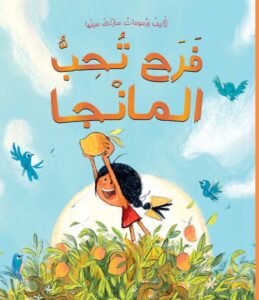 Farah Loves Mangoes
Farah Loves Mangoes 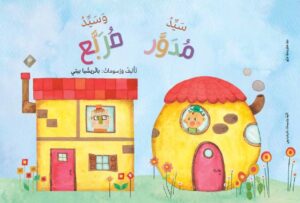 Mr. Round and Mr. Square
Mr. Round and Mr. Square 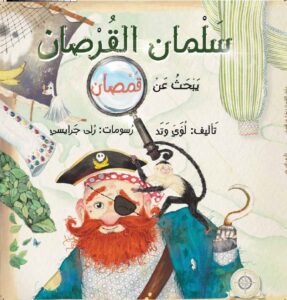 Salman the Pirate Searches for Shirts
Salman the Pirate Searches for Shirts  Good Night, My Star
Good Night, My Star 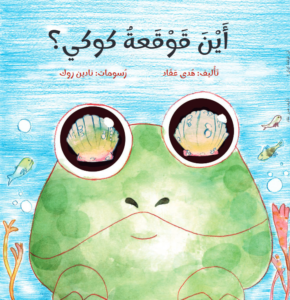 Where is Cookie’s Shell?
Where is Cookie’s Shell? 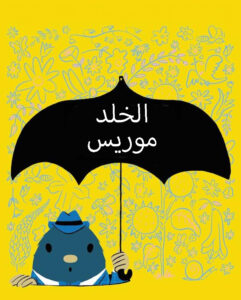 Maurice the Mole
Maurice the Mole 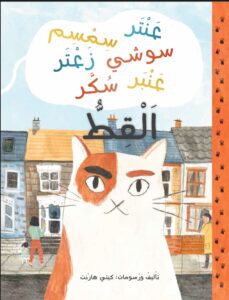 Archie Snuflekins Oliver Valentine Cupcake Tiberius
Archie Snuflekins Oliver Valentine Cupcake Tiberius 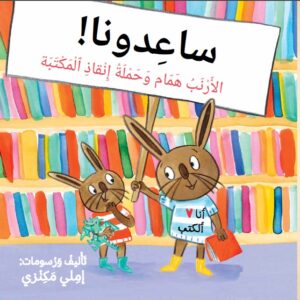 Help Us
Help Us 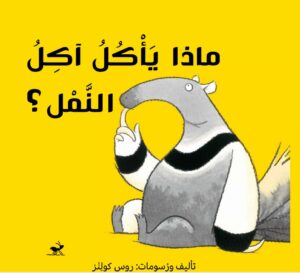 What Does The Anteater Eat?
What Does The Anteater Eat? 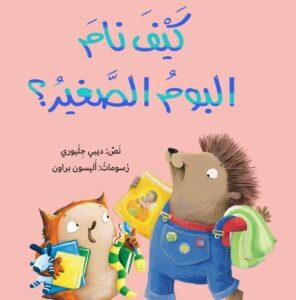 How the Little Owl Slept
How the Little Owl Slept 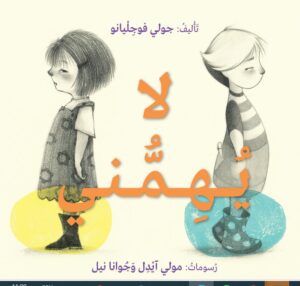 I Don’t Care
I Don’t Care  My Terrible Bag
My Terrible Bag  Stone Soup
Stone Soup  Fayloon
Fayloon  Where did Zaatar Disappear?
Where did Zaatar Disappear? 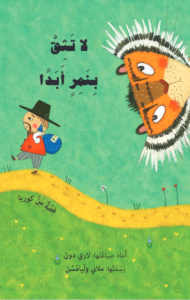 Don’t Trust The Tiger
Don’t Trust The Tiger 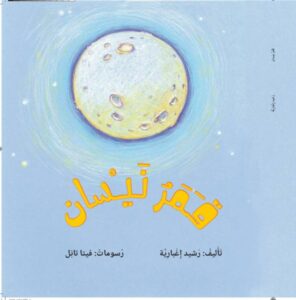 Nisan’s Moon
Nisan’s Moon 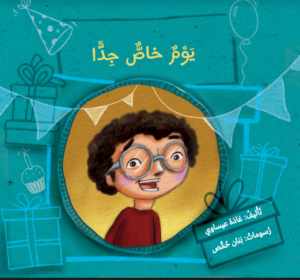 A Very Special Day
A Very Special Day 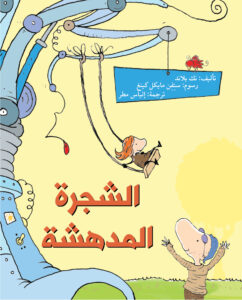 The Amazing Tree
The Amazing Tree 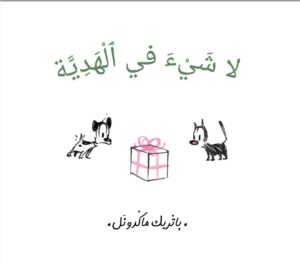 The Gift of Nothing
The Gift of Nothing 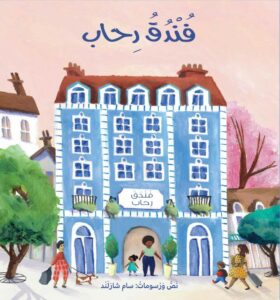 Rihab’s Hotel
Rihab’s Hotel 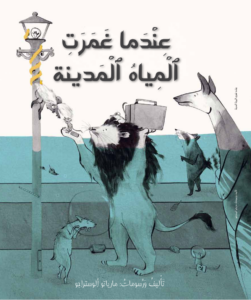 When Water Flooded the City
When Water Flooded the City 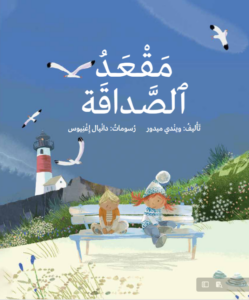 Friendship Bench
Friendship Bench  Oh Flying Bird
Oh Flying Bird 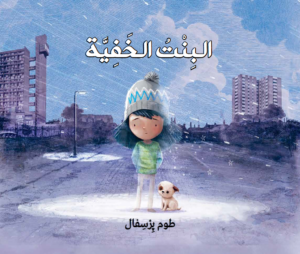 The Invisible
The Invisible 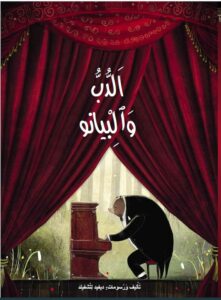 The Bear and the piano
The Bear and the piano 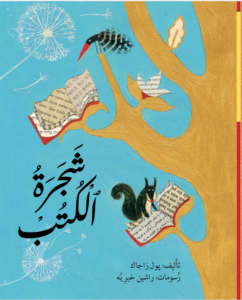 The book tree
The book tree 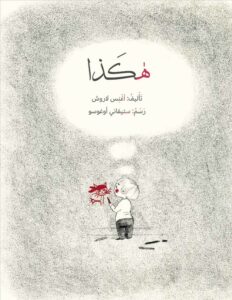 Because
Because 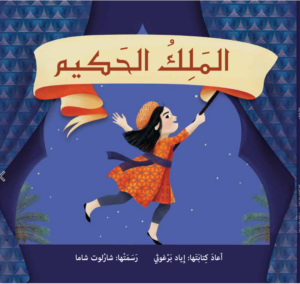 The Wise King
The Wise King 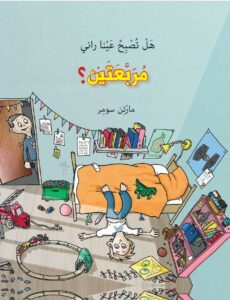 Will Rani’s eyes become square?
Will Rani’s eyes become square? 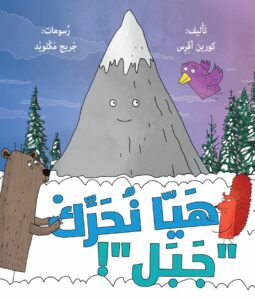 Move Mountain
Move Mountain 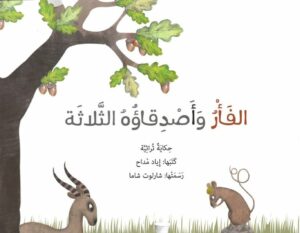 The Mouse and his Three Friends
The Mouse and his Three Friends 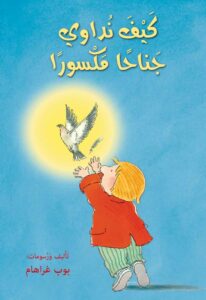 How to heal a broken wing
How to heal a broken wing 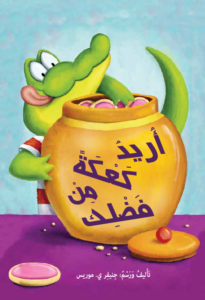 May I please have a cookie
May I please have a cookie 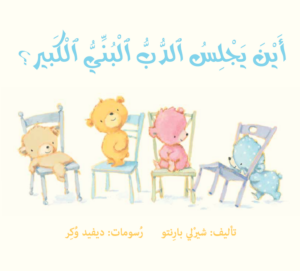 Bears on Chairs
Bears on Chairs 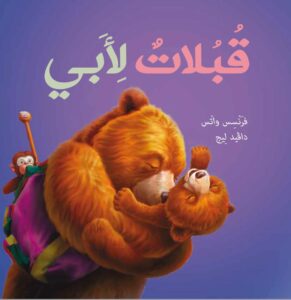 Kisses for Daddy
Kisses for Daddy 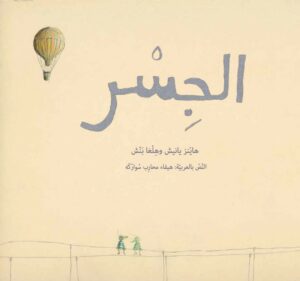 The Bridge
The Bridge 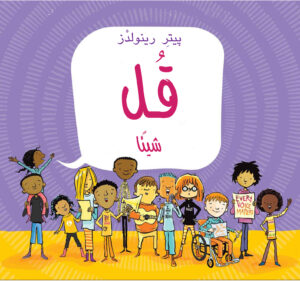 Say something
Say something  A Monster wrote me a Letter
A Monster wrote me a Letter 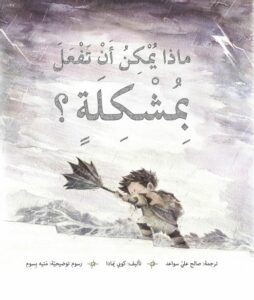 What do you do with a problem?
What do you do with a problem? 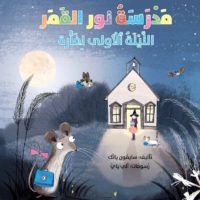 Mouse’s First Night at Moonlight School
Mouse’s First Night at Moonlight School 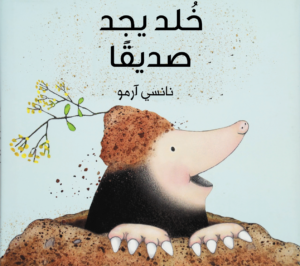 A Friend for Mole
A Friend for Mole 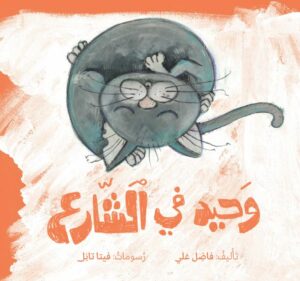 Wahid in the Street
Wahid in the Street  Sleep Tight Little Bear
Sleep Tight Little Bear 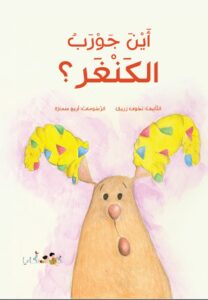 The Kangaroo’s Sock
The Kangaroo’s Sock 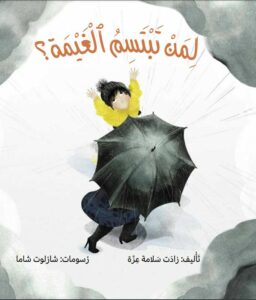 To whom the cloud smiles?
To whom the cloud smiles? 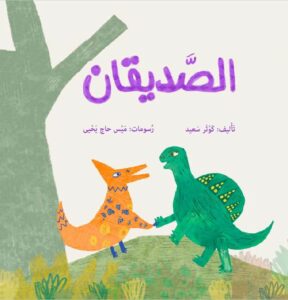 Two Friends
Two Friends 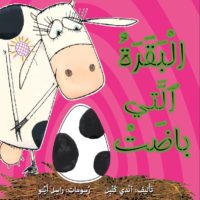 The Cow That Laid an Egg
The Cow That Laid an Egg 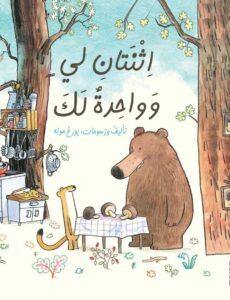 Two for Me, One for You
Two for Me, One for You 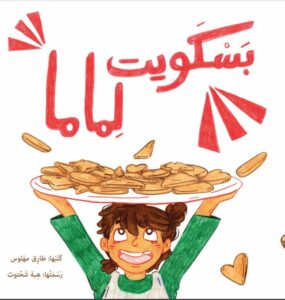 A Biscuit for Mama
A Biscuit for Mama 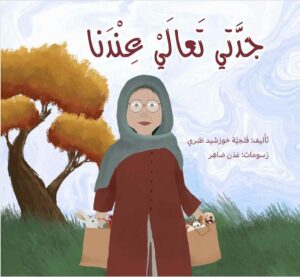 Grandma is Coming for a Visit
Grandma is Coming for a Visit 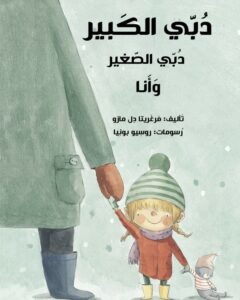 My big bear, my little bear and me
My big bear, my little bear and me 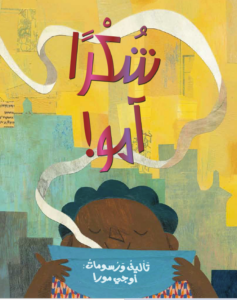 Thank You Omu
Thank You Omu 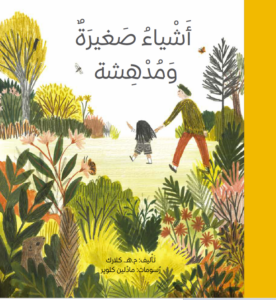 Tiny perfect things
Tiny perfect things 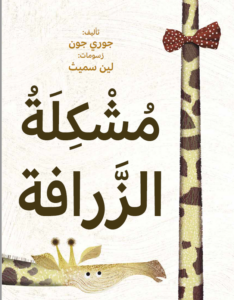 Giraffe Problems
Giraffe Problems 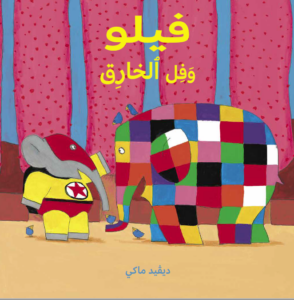 Filo and Super Phil
Filo and Super Phil 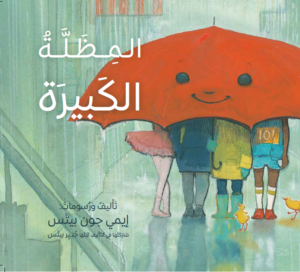 The Big Umbrella
The Big Umbrella 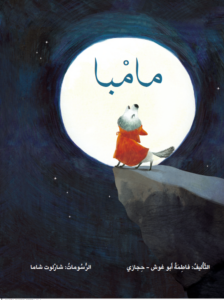 Mamba
Mamba 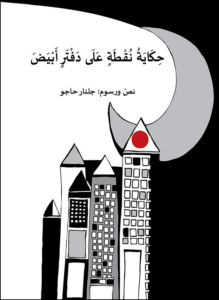 A Story of a Dot on a White Notebook
A Story of a Dot on a White Notebook 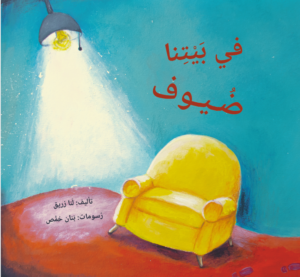 We Have Guests
We Have Guests 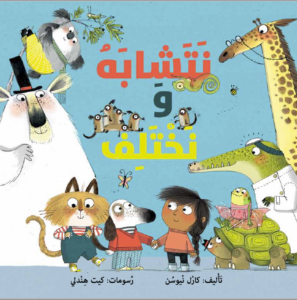 The Same but Different
The Same but Different 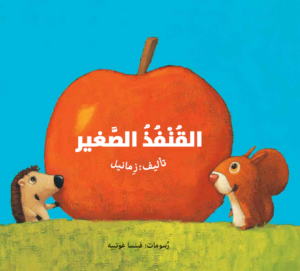 Little Hedgehog
Little Hedgehog 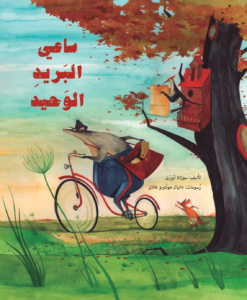 The Lonely Mailman
The Lonely Mailman  The Turtle Who Wanted to Climb Mount Everest
The Turtle Who Wanted to Climb Mount Everest 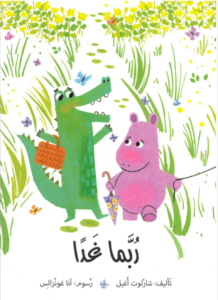 Maybe Tomorrow
Maybe Tomorrow 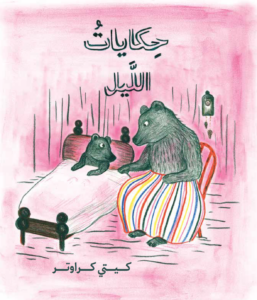 Stories of the Night
Stories of the Night 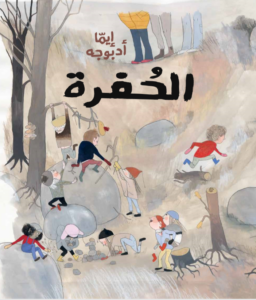 The Hole
The Hole  How Full is Your Bucket?
How Full is Your Bucket? 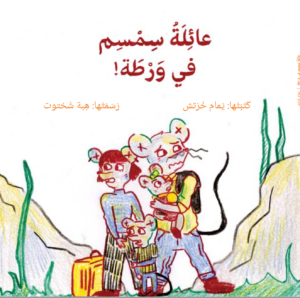 Simsim Family in Trouble
Simsim Family in Trouble 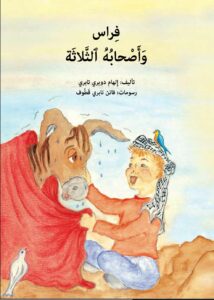 Firas and his Three Friends
Firas and his Three Friends  The Bunnies are not in their beds
The Bunnies are not in their beds 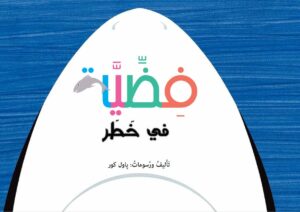 Caspion, Beware!
Caspion, Beware! 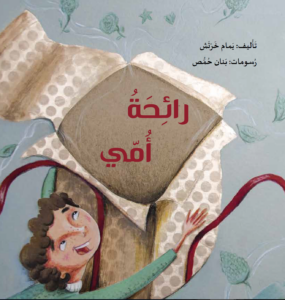 Scent of My Mother
Scent of My Mother 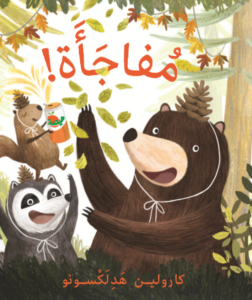 Surprise!
Surprise!  Extra Yarn
Extra Yarn 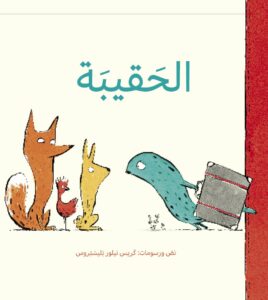 The Suitcase
The Suitcase 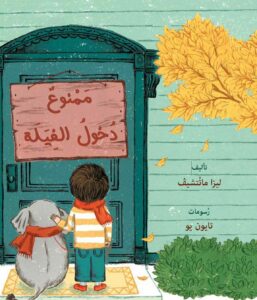 Strictly No Elephants
Strictly No Elephants 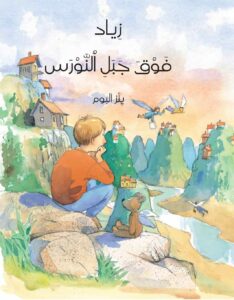 Ziyad on the Seagull Mountain
Ziyad on the Seagull Mountain 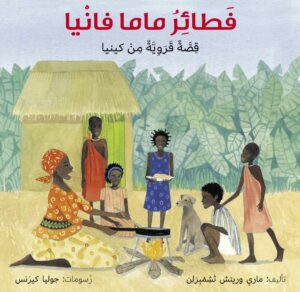 Mama Panya’s Pancakes
Mama Panya’s Pancakes 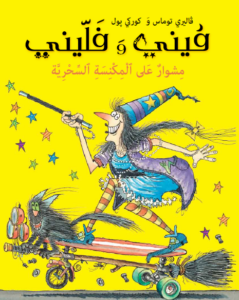 Winnie and Wilber: The Broomstick Ride
Winnie and Wilber: The Broomstick Ride  Emanual’s Dream
Emanual’s Dream 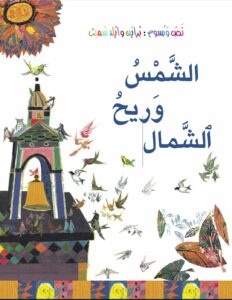 The North Wind and the Sun
The North Wind and the Sun 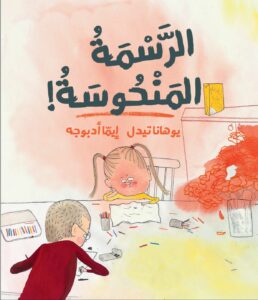 The misfortune drawing
The misfortune drawing 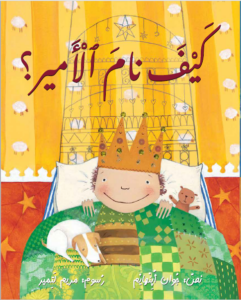 The Prince’s Bedtime
The Prince’s Bedtime 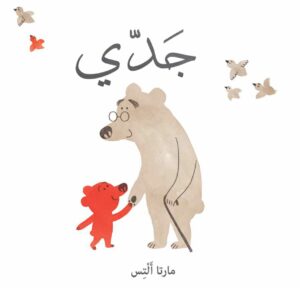 My Grandpa
My Grandpa 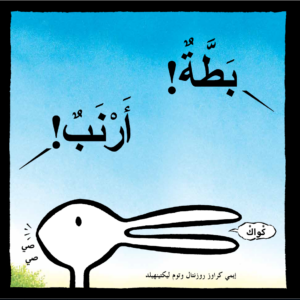 Duck! Rabbit!
Duck! Rabbit!  Hiding Heidi
Hiding Heidi 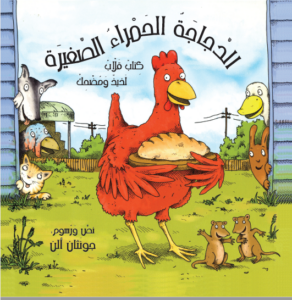 The Little Red Hen
The Little Red Hen 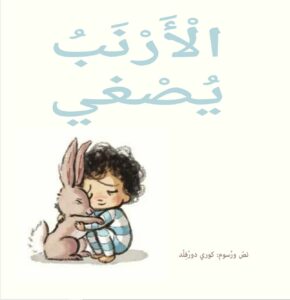 The Rabbit Listened
The Rabbit Listened 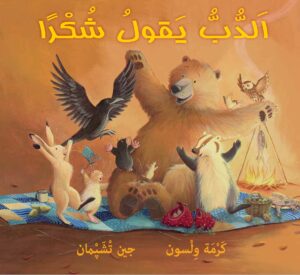 Bear says thanks
Bear says thanks 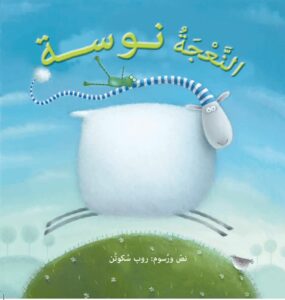 Russel The Sheep
Russel The Sheep 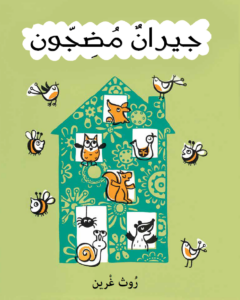 Noisy Neighbors
Noisy Neighbors 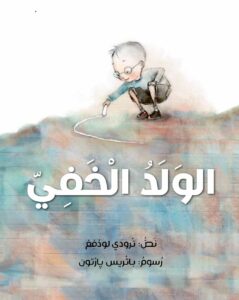 The Invisible Boy
The Invisible Boy 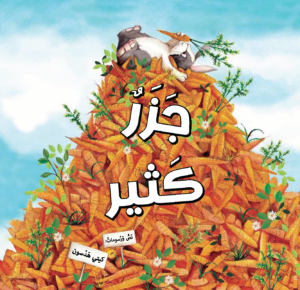 Too many carrots
Too many carrots 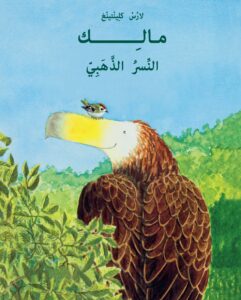 Malek, the Golden Eagle
Malek, the Golden Eagle 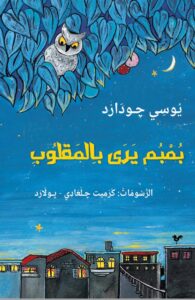 The Backward Owl
The Backward Owl 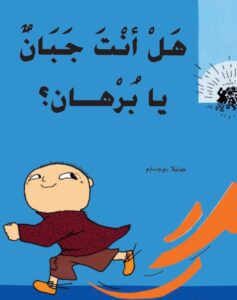 Burhan, Are You a Coward?
Burhan, Are You a Coward? 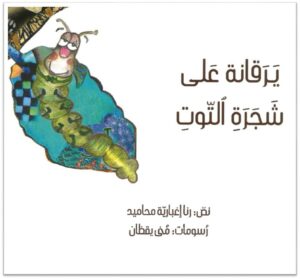 A Caterpillar on a Blueberry Tree
A Caterpillar on a Blueberry Tree  Winnie and Wilbur: The Magic Wand
Winnie and Wilbur: The Magic Wand 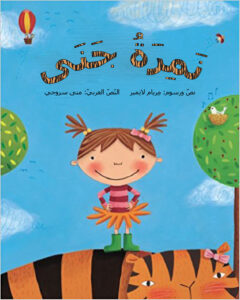 Emily’s Tiger
Emily’s Tiger 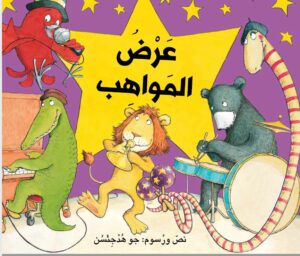 The Talent Show
The Talent Show  I Want an Elephant
I Want an Elephant 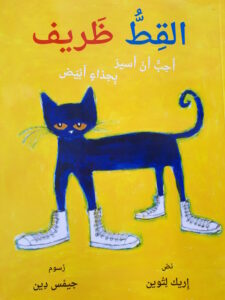 Pete the Cat- I Love My White Shoe
Pete the Cat- I Love My White Shoe 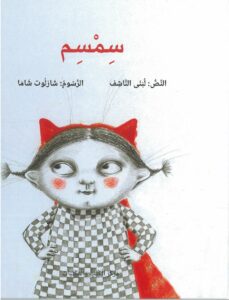 Simsim
Simsim  Doodle
Doodle  How Much I Laugh!
How Much I Laugh!  Oh Dear Geoffrey!
Oh Dear Geoffrey!  Saad and His New Cap
Saad and His New Cap 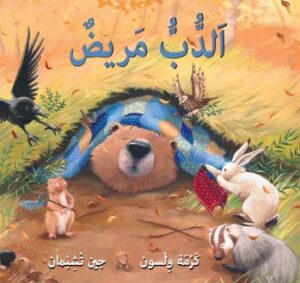 Bear Feels Sick
Bear Feels Sick  Soumsoum the Mouse (Al-far Soumsoum)
Soumsoum the Mouse (Al-far Soumsoum) 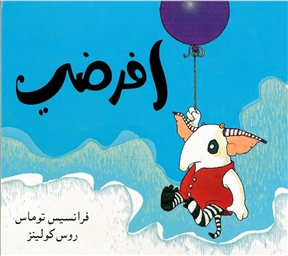 Supposing
Supposing 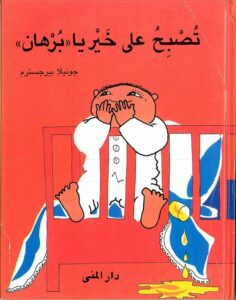 Good Night Burhan
Good Night Burhan 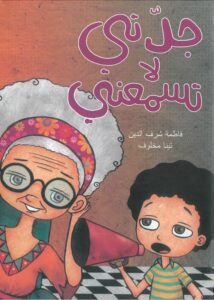 My Grandma Doesn’t Hear Me
My Grandma Doesn’t Hear Me 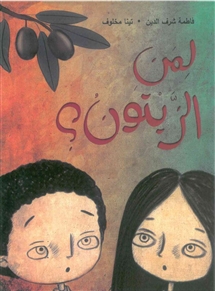 Whose Olives?
Whose Olives? 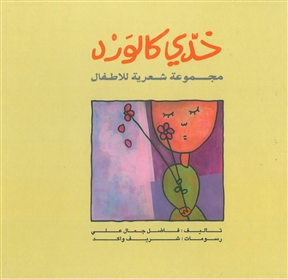 My Cheek is Like A Rose
My Cheek is Like A Rose  Nicolas Where Have You Been?
Nicolas Where Have You Been? 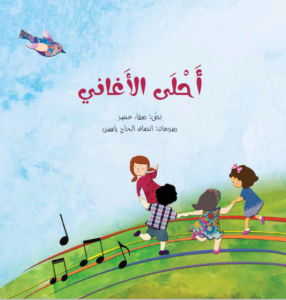 The Most Beautiful Songs
The Most Beautiful Songs 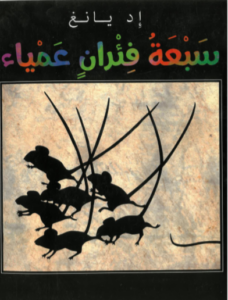 Seven Blind Mice
Seven Blind Mice 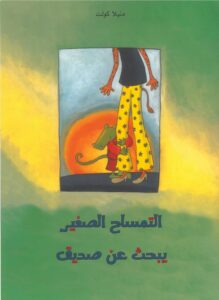 The Alligator Looks For a New Friend
The Alligator Looks For a New Friend 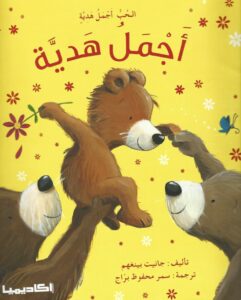 The Best Present
The Best Present  Monkey Puzzle
Monkey Puzzle 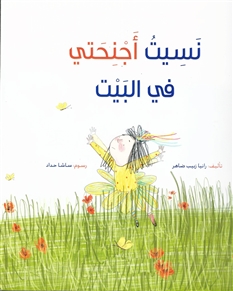 I Forgot My Wings At Home
I Forgot My Wings At Home 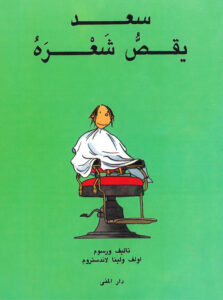 Will (Sa’ad) Gets a Haircut
Will (Sa’ad) Gets a Haircut 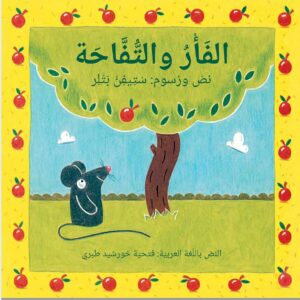 The Mouse and the Apple
The Mouse and the Apple  Good Night Little Ones
Good Night Little Ones 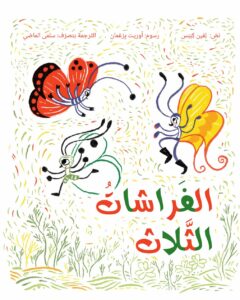 Three Butterflies
Three Butterflies 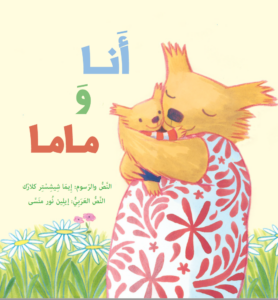 Mummy and Me
Mummy and Me 
